SECTION PAGE 6
Puppies brought to Raising Canes for adoption fair


SECTION PAGE 6
Puppies brought to Raising Canes for adoption fair

Alaska’s voters have options
By Kaycee Davis features2@thenorthernlight.org
Voting for the Nov. 8 general election has already started, Seawolves, so if you want to have a say and have registered to vote in Alaska, get yourself to the polls on or be -
fore Nov. 8. On the ballot, voters will get to rank their choice for governor, U.S. House and Senate, and state House and Senate, and vote yes-or-no on state judges retaining their appointments. This year, Alaskans get to an-
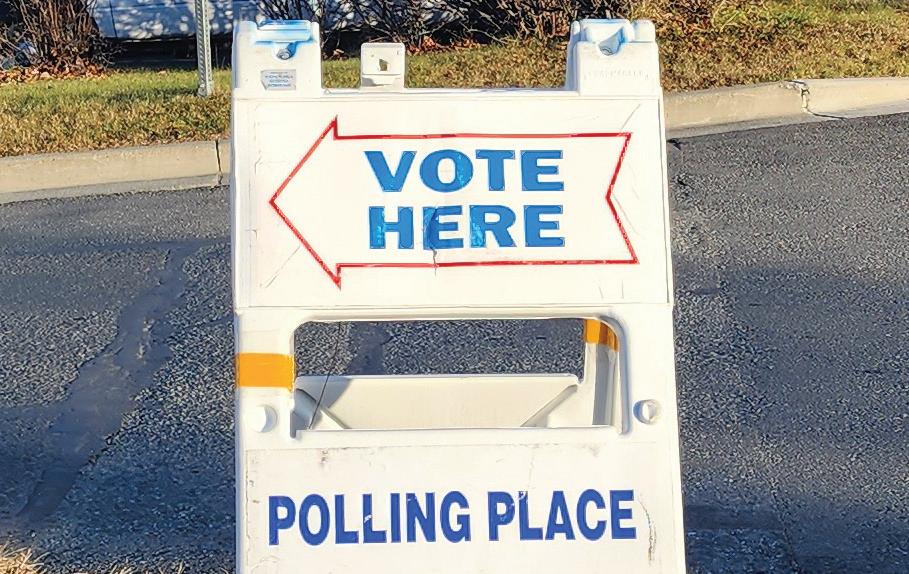
swer ballot measure 1, their once-every-ten-years question of whether or not they want to hold a constitutional convention.
Registered Alaskan voters need to bring an approved ID to the polls, which can be a drivers license, state ID card, passport, birth certificate, military ID, or a hunting or fishing license. Voters can also present a government document, paycheck, bank statement, or a utility bill with their name and current address.
According to the Division of Alaska website, “Absentee in person voting requires voters to complete an absentee in person oath and affidavit envelope which will be reviewed by the division and a bi-partisan review board
PAGE 9
‘Alaska Daily’ review: let’s start the conversation
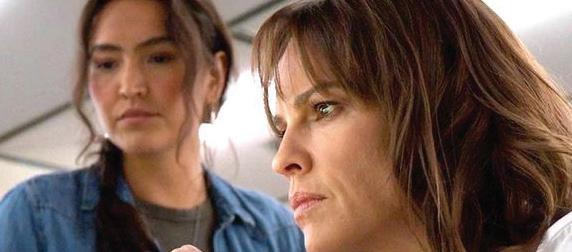
Seawolves volleyball takes No. 1 division II spot in front of nearly 4,000 people
By Avery Williamson sports@thenorthernlight.org
With two weeks remaining in the regular season, the Seawolves find themselves in the to No. 1 seed for the NCAA Division II tournament. Their 3-1 and 3-0 wins against the Northwest Nazarene Nighthawks and Central Washington Wildcats — in front of a NCAA record-breaking crowd — helped them keep that position.
The Seawolves faced off against the Nighthawks on Nov. 3 and won the game 24-26, 25-17, 25-22, 25-22.
The Nighthawks took the court with authority with hopes to improve their seed in the playoffs. They led early in
the opening frame, but the Seawolves rallied to earn a chance at set point at 2423. However, two straight attack errors and an ace by NNU gave the frame to the visitors.
The Seawolves trailed 10-12 in the second frame, but they gained momentum after a kill by Lisa Jaunet followed by eight straight points from Ellen Floyd’s serves. Eve
Stephens gave the team three more points off of kills. UAA won the second frame 25-17 to tie the game 1-1.
The third set featured 10 ties and four lead changes. After the Seawolves secured an early 10-7 lead, the score remained within one or two points until the
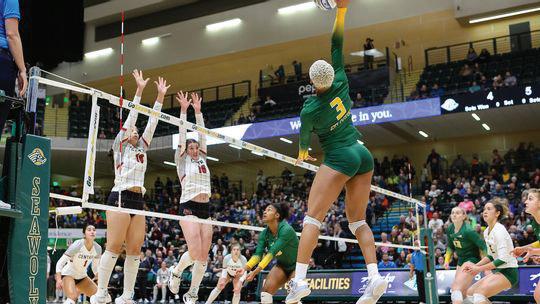
By Jasmine Grant news@thenorthernlight.org
In a Facebook post on Oct. 19, Seawolf Shuttle at UAA posted an official announcement that service would start up again on the 24th. The bus route follows a loop from Commons to Rasmuson Hall, EIB, SSB/Consortium Library, Fine Arts, and back to Commons, they wrote.
Location and estimated
arrival times of the shuttle Tracking services for the seawolf shuttle have been connected to the app Buswhere. Students can access tracking services with code ‘UAA’ which will lock the route into the app.
The shuttle is in partial-service with only afternoon and night service available until the second van arrives. Current service, referred to as Shift B, will run only from 1:00 to
ten pm. Monday through Thursday, according to the Parking Services page on UAA’s website. Shift A is expected to begin towards the end of November.
In USUAA’s Oct. 14th meeting, President Katie Scoggin said Shift A will run from 8:15 - 5:00 p.m. Two drivers had been hired that week and the second driver will start in November when the second shuttle arrives, she said.
Two Ford Transit U5X passenger vans were ordered with the aim to have both in service by early October, according to Seawolf Shuttle’s Facebook. Delivery of one of the vans was delayed due to supply chain issues and is now expected to arrive in early November.
The vans are equipped to seat eleven or nine passengers with room for an individual in a wheelchair. Each driver will have
two days of training, said Scoggin
Before the new startup, the shuttle service was run through UAA Facilities, Management, and Operations despite being funded through parking services, said Faola Harkins, a Parking Services employee at UAA. The previous shuttle vehicles were likely sold when the shuttle program shut down in the midst of COVID, he said.
The first of the new vehicles has been wrapped in Seawolf attire both designed and installed by UAA Copy and Print Center. New pictures of them can be seen on Seawolf Shuttles’ FaceBook page or in person! On Monday, they posted that green signage has been posted at all active stops and inactive stops are marked with yellow banners that include maps indicating the nearest active stop.
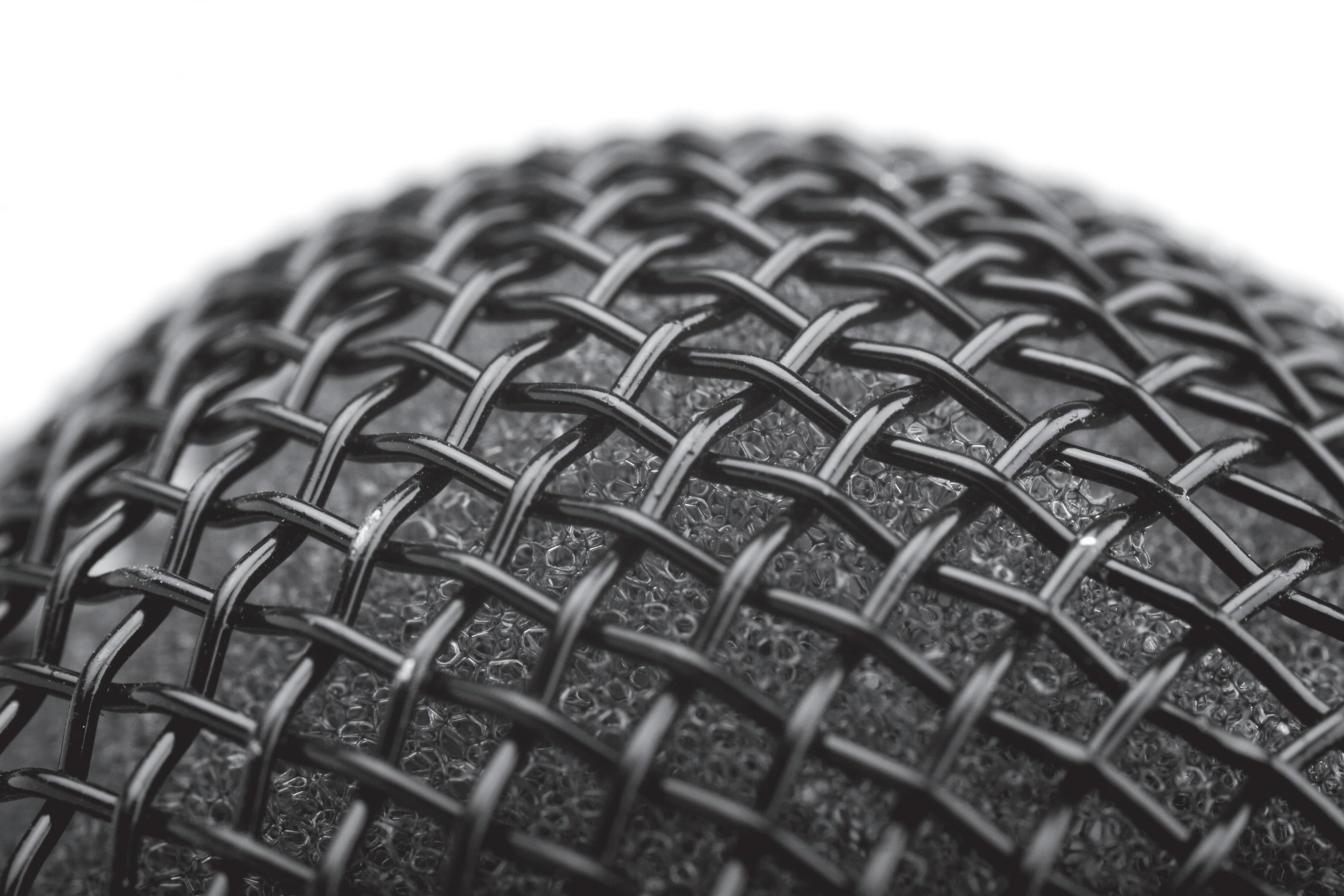
UAA puts students first, but only 100 of them?
By Avery Williamson sports@thenorthernlight.org
As people piled into the Seawolf Sports Complex on Oct. 1 to watch the first conference hockey game in over 900 days, UAA administration started to deny entry to students.
The student section - located around the ice rink - had reached its max capacity of 60 students, but over 40 were still waiting in line for seats. The leftover students were told they’d have to wait until the end of the first period, and if UAA’s partners – who have purchased 30 season tickets each to help reinstate the hockey team – still hadn’t shown up, the students could take their seats.
A little over six minutes in the open-
ing period, Connor Marritt scored the first Seawolf goal of the season, but only 60 UAA students were in the crowd.
Shanone Tejada, vice president of USUAA, was upset to discover that students weren’t being let into the game.
“So, initially we were told, as USUAA student government, that we weren’t going to deny any student from coming in,” said Tejada. “We weren’t going to turn students away even if we had reached the maximum capacity of 60 students.”
Tejada said he worked with administration to help get students into the game but was told that if UAA’s partners showed up the students would be removed from the stands. He also said he was told that only 60 students would be let into future games.
On Oct. 5, Tejada received an email from administration stating that they’re
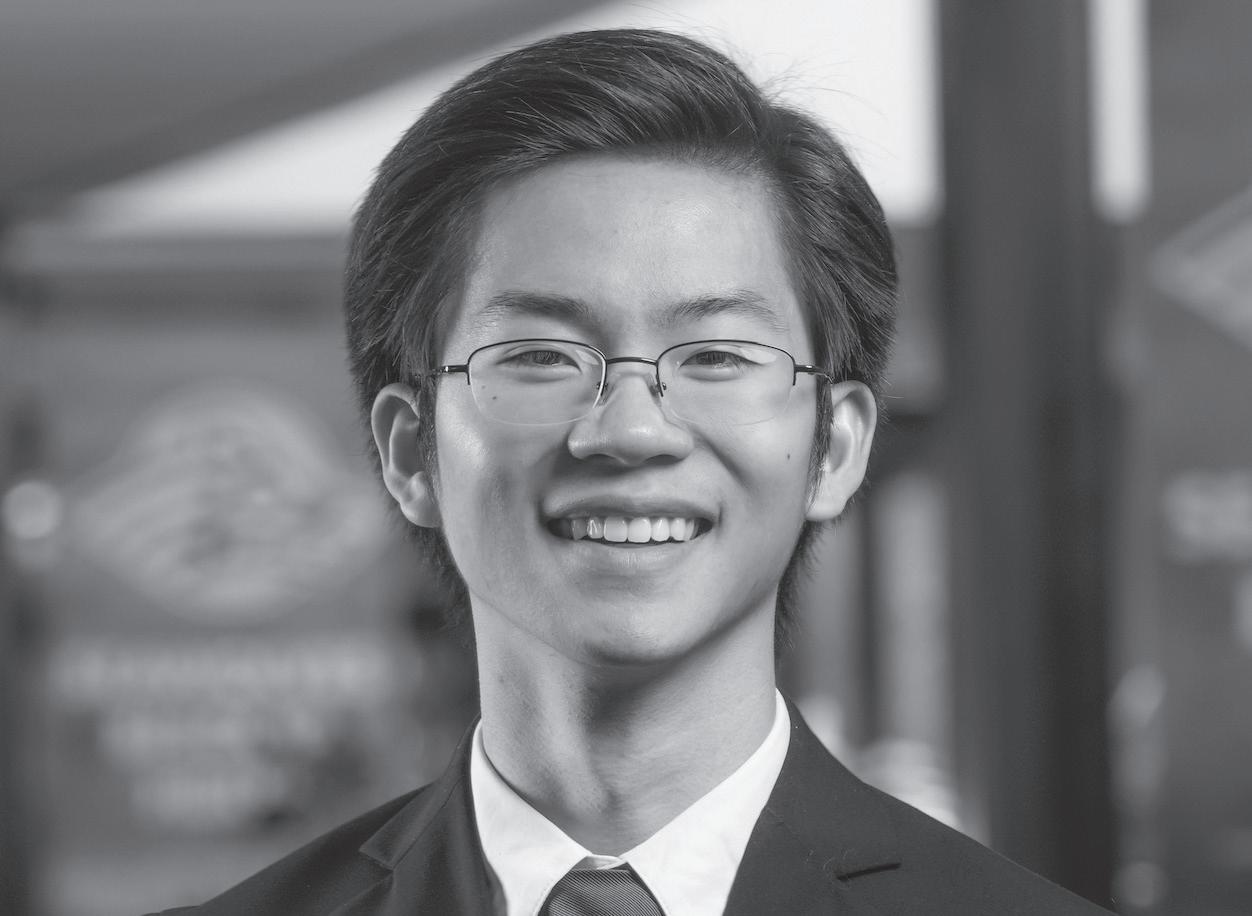
increasing the maximum capacity to 100 students. “That might calm the worries that students have right now, but does UAA athletics adhere to UAA 2025?” said Tejada. “That mission and vision of what UAA should be?”
The mission of UAA 2025 is to put students first. “Does that look like limiting it to 60 students?” asked Tejada.
Tejada said that refusing to let students into the games is a violation of their tuition - which includes athletic events. “We’re selling each of these seats for $15 a pop,” said Tejada. “As a student who’s in their senior or junior year, that’s from out of state, that hasn’t established residency in Alaska, that lives as a student on the residential campus, they well pay more than $9000 a semester in tuition.”
Tejada said he’s working with administration to find a solution. “There needs to be a conversation about where the student section should be,” said Tejada.
He proposed to administration that the student section be moved to the Section D bleachers - which are alcohol-free - and that space around the ice should be a VIP section or designated beer garden.
“If the public really wants to get back into those stands, why don’t we put them behind the ice?” said Tejada. “Call it a VIP section because they’re up against the glass where the players are at. Or, make it exclusive to alcohol, like a beer garden. People want that experience up against the glass, banging against the glass while drinking beer. That is why people come to games.”
Tejada also said his proposal would make it easier to regulate where alcohol is since there’s only one entrance to the ice. However, Tejada said it doesn’t look like that plan will be put into effect this year. As of right now, only 100 students will be let into the game initially, and then, if UAA’s partners don’t show up by the end of the first period, students will be allowed to take their seats.
Tejada is worried that if administration doesn’t take action soon students will start to boycott games and protest that UAA is not putting them first.
Alaska’s increase in minimum wage for 2023 still does not match standard of living expenses in the state
By Jasmine Grant news@thenorthernlight.org
The state of Alaska is set to increase minimum wage by 51 cents in response to a 4.9% inflation increase in 2021. This will raise the state’s base pay from $10.34 to $10.85.
Website Minimum-wage calculates that individuals working full-time in Alaska at the current minimum wage will earn $413.60 per 40-hour work week and $21,507.20 each year before taxes.
This is well above the Department of Health and Human Services puts the poverty line for a single person-household in Alaska at a $16,990 salary in their 2022 Poverty Guidelines but still may not be enough to live comfortably. A Living Wage Calculation for Alaska in 2022 by The Massachusetts Institute of Technology suggests a reasonable wage to cover all living expenses for an adult working full-time without children in Alaska would be $16.72 or $34,786 annually be -
fore taxes.
Researchers at MIT described their living-wage model as a “step-up” from the poverty line and adherent to a number of basic necessities. According to their estimate, minimum wage in Alaska, even with supplemental wages such as tips and the PFD, is likely not a living wage for independent adults.
Though minimum wage in Alaska may not reflect the estimated value for subsistence, it does have guaranteed increases reflective of the state’s rates of inflation. Residents voted on a ballot initiative in 2014 in favor of adjusting minimum wage by yearly inflation, according to the Office of the Commissioner of the Alaska Department of Labor and Workforce Development.
This led to the instatment of Alaska statute 23.10.065, a law requiring minimum wage be “adjusted annually for inflation” in accordance with data provided by the U.S. Bureau of Labor Statistics consumer price index for urban Alaska.
In a press release on Oct 5, 2021, the
Office of the Commissioner reported that the calendar year of 2022 was not eligible for an increase in minimum wage as its corresponding year saw a -1.1% change in inflation.
This makes 2022 the only year where minimum wage did not increase since the adoption of the annual wage adjustment statute. The evaluated year for adjustment was 2020, the year the coronavirus hit and the only year Alaska has ever experienced deflation since the consumer price index started collecting data in 1960.
Federal minimum wage, established in 1938 within the Fair Labor Standards Act (FLSA), has never kept up with inflation or productivity rates and has not increased from $7.25 since its raise in 2009. If minimum wage had been progressively adjusted for inflation it would come out to $21.50 in today’s market, according to senior economist Dean Baker at Center for Economic and Policy Research, but many advocates are aiming for a $15.00 federal minimum wage.
The federal minimum wage for students is even less at $6.16. MinimumWage states that full-time college or high school students working part-time may be paid 85% of the Federal minimum wage for up to 20 hours of work each week under certain employers such as university work-study jobs.
OCT. 24 - OCT. 31
Total UPD calls for service: 289
Total locks/unlocks: 1
Offenses/incidents:
Accident Date: Oct. 24
Location: West parking lot
Theft in the third degree $250 - $750 Date: Oct. 24
Location: Gordon Hartlieb Hall
Assist other agency Date: Oct. 24
Location: Providence Alaska Medical Center
Assit other agency and accident Date: Oct. 26
Location: UAA Drive / Northern Lights Boulevard
Assault Date: Oct. 28
Location: Alaska Airlines Center
Medical emergency - injury - and criminal trespass in the second degree
Date: Oct. 29
Location: Templewood Apartments
Tejada wants students to know that USUAA will continue fighting to make it so all students can attend hockey gamesnot just the first 100.
“What I want people to know, especially students, is that I don’t want you to think your voice can’t be heard,” said Tejada. “I’m a firm believer in ‘if you can’t make them see the light, make them feel the heat.’ If administration is not going to listen to us, they’re going to be forced to.”
Jobs at UAA usually pay a bit higher with common starting wages of $11.34 or $12.03 an hour. Higher-paying positions are also available for masters and PHD students working as graduate assistants. The U.S. Department of Labor Wage and Hour Division requires all employers to visibly display an approved minimum wage poster, and other Alaska and federal labor law posters, The Fair Labor Standards Act (FLSA) to ensure employees know their labor protection rights in terms of wage and overtime regulations.
This is important as Alaska has many migrant workers, many of whom are from non-English speaking countries such as the Philippines, Mexico, Thailand and Korea. Roughly one in nine, or 11%1, of the workforce in Alaska were migrant workers in 2018, according to a 2020 report by the American Immigrtion Council.
In some places, migrant workers, especially those who cannot speak fluent English or are of illegal status, can be taken advantage of by employers underpaying or overworking them. An analysis of U.S. Census Bureau data by the Center for Public Integrity found that immigrantdominated industries also had the most prevalent rates of wage-theft, despite immigration status holding no weight over compliance with FLSA.
Raising the minimum wage could have other benefits to the Alaskan economy. The concern that immigrants are taking jobs from Americans isn’t much of an issue inAlaska. In fact, the Alaskan economy would benefit from more workers, whether from other states or countries. Adjusting minimum wage to match living expenses could help attract workers from out of state to fill jobs in Alaska.
Chancellor knows what makes students tick so they talk
By Kaycee Davis features2@thenorthernlight.org
Homecoming weeks festivities and events included the Fall Fireside Chat with Chancellor Sean Parnell & Cabinet in the Student Union Den on Thursday, Oct 13. Sitting in front of the fireplace in the Den, Parnell introduced his cabinet, as well as Ryan Buchholdt, Vice Chancellor of Administrative Services, and Denise Runge, Provost & Executive Vice Chancellor. Sitting up front in the audience were members of the UAA gymnastics team.
At 11:30 a.m. when the meeting started, there were around 50 students and staff members in the Den.
Highlights of the discussion were students and faculty discussing Parnell’s vision for the Strategic Plan 2025 and how his leadership team is making college easier for the students. Parnell mentioned that they had noticed that the Board of Regents had been raising tuition by 5% every year for many years. Parnell said that his team asked them not to, and said that they will ask again. Buchholdt was able to reduce parking fees by 25%. Parnell said with“the cost of gasoline going up, the cost of groceries going up” that they want to
make it easier for students and “drop the barriers” for students coming to UAA.
Many important topics were brought up, but the overwhelming star of the show was Parnell and his ability to communicate with students. Anyone familiar with him would say this could be expected, given his background as a lawyer and politician. Every member of his cabinet —be they sitting amongst the students or on stage with him — gave their full attention when audience members spoke up. They made eye contact, they smiled appropriately and they responded as active listeners.
When Parnell pitched to the audience a question, there was sometimes silence. He would joke, and there would be laughter and silence again, then he would ask for students to share a story about their favorite professor or faculty member, or to talk about what brought them to UAA. Audience members smiled as they internally reflected on the answers, with some sharing.
Sara Childress, M.S.W. and director of the Office of Equity and Compliance was asked about barriers to reporting Title IX violations. She said that the office didn’t just want “the red flags… but the yellow
flags… it could just be a sexist comment made by faculty in a class ... Or a peer or a student bullying another student.”
Childress said, “most of [the reports] come from faculty or [someone] in residence life” and that they encourage people to report, regardless of how much information they have
“Even if you don’t think you have enough information, the second you report it … we’ll take it from there. There’s nothing more the reporter has to do, you’re done… just a little information for us and we take it from there.”
She said people “send a simple email .. you can call … Some people call just to ask us ‘should I report this?’ Guess what, you just did!”
Parnell was watching the audience and introduced various people who walked in. When UAA Student Body President Katie Scoggin and Vice President Shanone Tejeda came to the chat midway through, Parnell explained the work that they do, and the work he does with them, mentioning the UAA Caucus and “substantive issues” that they discuss.
The meeting ended on a high note when an audience member asked, “What are you doing to support Native students and Native programming?” This gave Parnell the chance to mention the
plans for UAA shuttle service, name of Thanksgiving Break, sports games capacity, and goals discussed at meeting with
By Jasmine Grant news@thenorthernlight.org
UAA guest speakers met with the Union of Students on Oct. 14 to discuss updates on Seawolf Shuttle service, academic holiday names, and developments in UAA strategic plans.
The first guest speaker, UAA Chancellor Sean Parnell, asked council members to support the decision to extend the UAA 2025 Strategic Plan by two years to 2027.
UAA 2025 is an initiative centering around five aspirations of overall improvement for the institution. The initiative was finalized toward the end of 2020 and approved by the University of Alaska Board of Regents on Feb. 25, 2021.
Around the same time, the board authorized the development of the Alaska Native Success Initiative, which aligns with the second priority of UAA’s 2025 Strategic Plan of cultivating a culture of equity and inclusion by embrac-
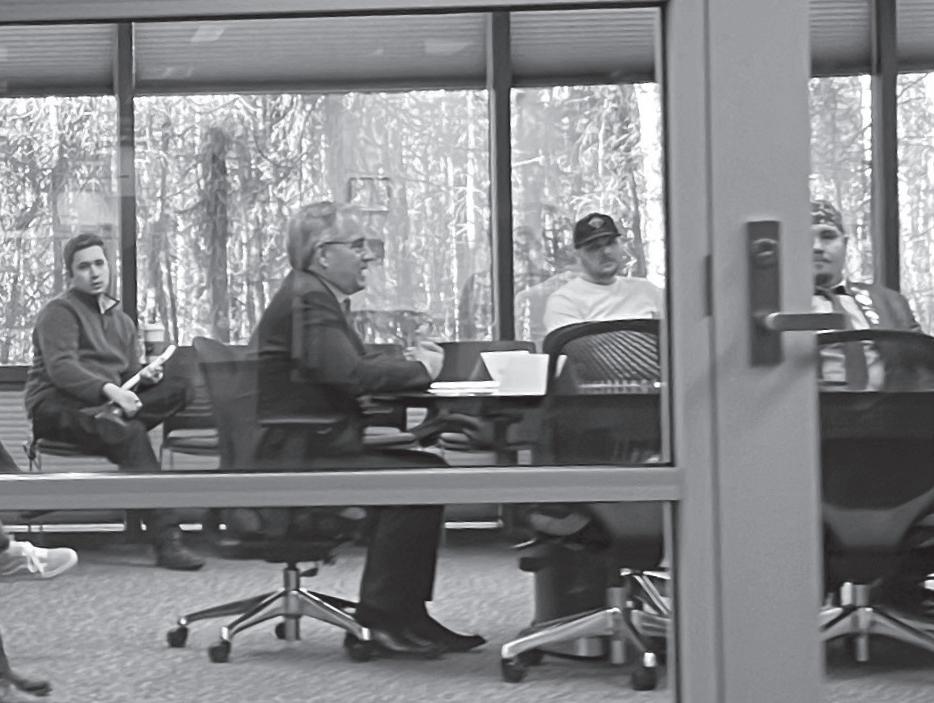
work of the Alaska Native Success Initiative where he said they were looking at hiring Alaska Native staff and faculty and “making sure that Alaska Native success is part of our DNA… that it is a part of who we are and how we move.”
He hired Michele Yatchmeneff, executive director for Alaska Native Education, and through her department she has worked with other colleges at the dean’s level “to implement their own action teams to take on the challenge… for staff, faculty and students… to create environment, culture and atmosphere” for success. It was here that Parnell said that this was for Alaska Native students, but also for everyone, where everyone belongs.
“We want you to bring all you are into this community.”
He said his administration wasn’t going to see what worked for one group of students and stop there, he wanted that to extend what worked to everyone.
The Chancellor and his team have several opportunities to engage with students throughout the year, and they want to hear from the faculty, staff, and students. Watch for meetings in the future and bring your questions or just drop in and watch to see how the administration interacts with the student body.
hockey games from 60 to 90 students. Students are advised to show up early to secure their spots. They may have to wait if capacity is reached but will not be turned away regardless, said USUAA President Katie Scoggin.
ing diversity. ANSI is dedicated to improving the representation, participation and success of Alaska natives in the Alaska university system, according to UAA’s ANSI Strategic Plan Executive Summary. Good progress has been made regarding the Alaska Native Success Initiative, said Parnell.
UAA’s ANSI features three main priorities for the native community with specific goals for each priority. These goals aim to increase native faculty, enrollment and graduation rates, and university resources for the community.
USUAA advisor Zac Clark announced that applications for a USUAA student arts, activities and entertainment coordinator are still available through the 24th of October, as the position was recently vacated.
After a meeting with the Director of Athletics, Ryan Swartwood, USUAA was able to increase student capacity at Seawolf
Drivers have been hired and routes have been set for the Seawolf Shuttle Service, said Scoggin. Expected to start on Monday, Oct. 24. is Shift B of the service, prioritizing the afternoon and night and running from 1:00pm to 10:00pm. USUAA is hopeful that the app for the shuttle service will be active by this date as well.
The assembly then discussed the possibility of renaming Thanksgiving Break to Fall Break on UAA academic calendars. UAS and UAF recently passed a resolution regarding the change to be submitted to the board of regents. The resolution stated the historical trauma of Thanksgiving for some students and staff and the fact that many do not celebrate the holiday as reasons for the switch. USUAA is considering following their decision and sending out a campus-wide survey to collect opinions on renaming the academic holiday.
By Taylor Heckart Contributing writer
Along Wellness Street large green poles are covered in bright orange plastic bags. Pieces of laminated paper are taped to the front reading, “OUT OF SERVICE,” covering the original emergency buttons. Known as “blue light emergency phones,” these out-of-commission poles are scattered across campus, leaving one of UAA’s methods of campus safety in operational.
In an interview with the Associate Vice Chancellor for Facilities & Campus Services Kimberly Mahoney, she said the emergency phones started having issues three years ago. Annual night safety walks revealed that the emergency phones were intermittently flipping between working and not working. It wasn’t until recently that the university finally found the culprit: The copper lines that connected the phones to the system.
“Today, most things need low voltage power to work,” Mahoney said.
In addition to the emergency phones, copper wiring has also been a part of UAA’s elevator emergency phones and fire systems. Facilities will be upgrading elevators and fire systems first, but Mahoney said that upgrading the emergency phones will still be a priority.
University Police Department Chief Jeff Earle said the emergency phones are “used from time to time by members of the community, students, and staff.” Even with the emergency phones down, Earle said there are other ways that people on campus can stay safe.
In an emergency people can call 911 on their cell phones regardless of whether they have a cell carrier or not. Earle also said that UAA students can use the RAVE Guardian app. Through the app, individuals are able to set safety timers, discreetly contact UPD, call for help, and stay informed on campus safety.
Both Mahoney and Earle said that getting the emergency phones operational again is a priority at UAA. However, due to supply chain issues that impact ordering parts, repairs have been delayed and there is no date for when they will be repaired.
Copper wiring, however, has been a mainstay of many emergency systems because copper will still continue to work in the event of a power outage. It’s only recently that emergency systems have been transitioning away from copper and toward wireless communications systems.
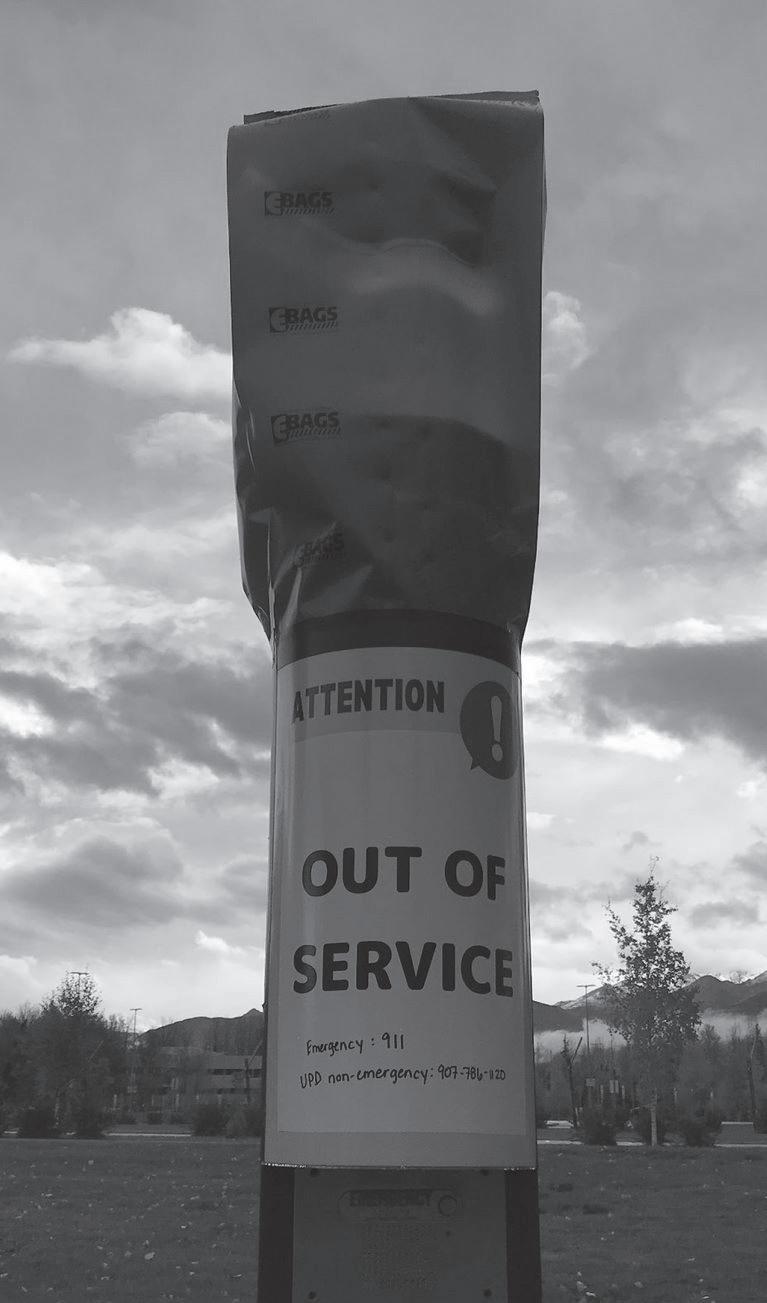
By Kaycee Davis features2@thenorthernlight.org
You may have passed it while walking on the way to class, The Student Health and Counseling Center — located on the first floor of Rasmuson Hall — is an affordable venue for UAA students needing primary health care and mental health services, including a sports or wellness exam, vaccinations, bloodwork, or sessions with a mental health counselor or practitioner.
TNL spoke to SHCC office and fiscal manager Michele Bach, who shared that the center now operates on an appointment only basis, adding that they can take same day appointments for medical and mental health issues depending on the urgency.
The student health and counseling center includes a medical doctor on staff, advanced nurse practitioners, licensed professional counselors and psychiatric nurse practitioners.
UAA students “taking at least one credit,” Bach said, are able to get the full benefits, as well as a student who is at UAA from another UA campus, though the fees may be different. Professionals at the SHCC also make referrals to providers within the community.
Bach said that keeping costs down is important to students, and has a convenient price list of the most used procedures at their website. A student can always call for a quote. The providers see eligible students for all primary health care and mental health care needs with no charge for the office visit. Remember students under the age of 18 need to have a parent or guardian sign a consent-to-treat form prior to treatment in most cases, so
when making an appointment the health center will discuss this.
SHCC bills some insurance providers, and it is best to call ahead to inquire. It is not mandatory that a student carries insurance, so charging their student account, or paying out of pocket is always an option if there are charges during the visit.
Another alternative to pay for charges incurred from a visit with the health center would be through available financial aid. Financial aid generally pays for standard services — academics and housing — a student could complete a Title IV waiver allowing their money to pay for medical fees as well. The health center will provide the form at the time of visit for interested students.
SHCC does more than take care of student’s mental and physical health – they also have health promotion and wellness under their umbrella. They operate The Bystander Intervention program offered by peer health educators, supply emergency food bags to students in need through donated funds called The UAA Food Insecurity program, and work with the Alcohol, Drug, and Wellness Education Program to support student wellness on campus.
They will be presenting a health fair in Rasmuson Hall on Nov 3. Bach said that the health fair is only in the fall semester and will not be held again in the spring. It will be a well attended event with many health related information booths ready to interact. Look for event advertisements coming soon on the Seawolf Bulletin.
To learn more about the SHCC, visit their website at https://www.uaa.alaska. edu/students/health-safety/health-counseling-center/
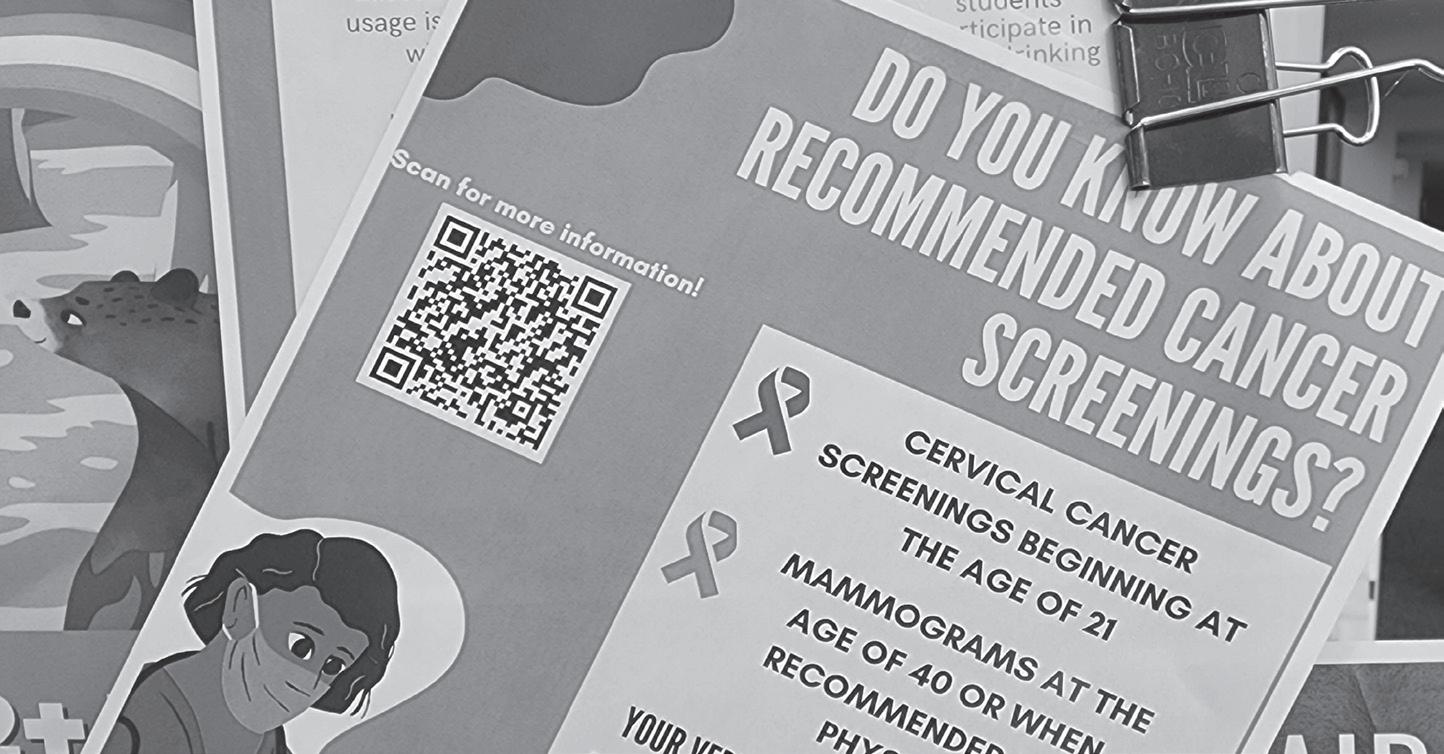
Local health fairs promote affordable wellness and preventative medicine
By Kaycee Davis features2@thenorthernlight.org
If you haven’t been to them you may have seen them going on. Schools, hospital foyers, churches, and other public venues have been popular locations for public health fairs for years. Local health practitioners, providers and health support services have tables to share their services, and often there are specialized services for physical exams and blood draws.
Betty R. of Alaska Health Fair, Inc shared with TNL that they do public and private health fairs, where they do screenings “wherever we are invited.”
The culinary arts’ hidden gem in the Lucy Cuddy Hall is closed for the fall semester
By Kaycee Davis features2@thenorthernlight.org
You had better order fast because, as they say, the early bird gets the worm –and in this case, it is the carby goodness.
Since 2018 Chef Vern Wolfram and the Culinary Arts A111 Bakery Skills Lab has been behind The Bakery Cart, a pastry cart in the Lucy Cuddy Hall, which serves snacks on Wednesdays and Thursdays. Chef Kellie Puff said that the class teaches commercial kitchen skills and, in particular, increasing the size of batches.
Prior to COVID, the UAA community would come in person to buy the baked goods, but with the pandemic, Puff said that they “had to adapt” and put their wares online. During COVID, customers would do curbside pickup. The purchasing is competitive, she said, considering that there is a limit to the food her class makes.
“It opens at 10:45 and shuts down at 12:15, but it often sells out by 11 a.m.”
It is tradition that the students serve biscuits and gravy on opening day. Puff said that what they offer changes as the students learn new skills throughout the semester, but there are “staples like cookies, brownies, scones and muffins” that are always on the offering.
“Sometimes a batch doesn’t come out quite right but is still good, so students learn how to save it by transforming it.”
One of those items that becomes transformed is the standard ham and cheese croissant which can be turned into savory monkey bread.
On Wednesday Oct 13, I sat in my car and got online at 10:44 a.m. The website was not in action, and after a few tries, I was on. Savory monkey breads, spanakopita turnovers, and bowls of soup were
ordered. Ordering was easy, but the website needed my credit card number. In the midst of ordering, product availability was reduced and adjustments had to be made. Went to the curb to meet the culinary artists who had made the food. After I chatted with the makers and teachers, I took my order to my husband’s office. The smell of food brought several coworkers to join us in the lunch room where the food was unanimously pronounced, “Delicious.”
Pickup is by the sandwich board at the Cuddy entrance facing Rasmusen Hall at Lucy’s. I spoke with some of The Bakery Cart patrons. They were UAA staff, students and others from the community.
A graduate of the culinary arts program, Briana Brown came for her order and said that she had “good memories” of the program, as evidenced by the warm greetings between her and former classmates. Roderick Horner, a lab aid to Chef Noah Miller, shared how he got into the program after getting a nursing degree in the military. “I served three tours,” he said, “I had some great experiences, but I love cooking.”
Does the food sound good? Want to try it out? You had better act fast – the last day of operation is Oct. 20. If you miss it this time, remember that The Bakery Cart opens two weeks into the new semester, every semester. Check out their website and be ready to pounce as soon as it opens.
The next phase of the Bakery Skills Labtakes students and the UAA community into Lucy’s, a dining experience in Cuddy Hall, opening on Nov. 3. Seating is by reservations only, though online ordering is available at uaaculinaryarts. mobilebytes.com. Reservations for Lucy’s will be available by calling (907) 786-1122.
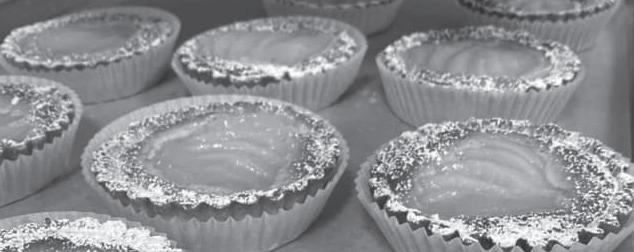
screen, for extra fees there are men’s and women’s “wellness packages”, and an ala carte menu of other blood tests, such as ferritin (iron), thyroid, vitamin D, and prostate screens, with prices listed on their website. They do not often do testing through their offices as they are small, so patients call and make an appointment for the next public fair.
Why should anyone go? Betty said, “People come to health fairs because they get tests done that cost more through their doctors.” Among screenings that are available, they have cancer, hearing, vision and glaucoma screenings. Betty said they are all different. They cannot replace a doctor, but they can help in recognizing problems.
Betty said,“Doctors often send their underinsured patients to us for blood work. A blood chemistry screen of 27 panels that costs $900 only costs $45” through Alaska Health Fairs, Inc., and the information gets mailed to the patient, not a doctor where they need to make an appointment to review their results.
In addition to the 27 blood panel
Beyond what Alaska Health Fair, Inc does for patients, at any health fair there is a different selection of presenters. They do not pay for their tables or booths — they are not selling anything — only making patients aware of their services that are health related.
TNL went to the health fair at the Anchorage Rasmussen Museum and met presenters from the National Institute on Mental Health and picked up folders on “navigating a mental health crises” and “starting a conversation about mental health”. The information was free and the presenter was happy to share what NAMI does.
Fairgoers could browse tables decorat-
ed as if for little parties, with little swag bags that had room for candies, stickers, pamphlets, and coloring books. Attendees were having active discussions with two hospice groups, a masseuse, a yoga teacher, United Way, and two groups who work with brain injuries. Many fairs have more tables, but this one filled up the space allocated. There was a fast moving line of people there to get blood draws, and the mood was upbeat.
Betty pressed upon TNL the need for volunteers. “We have medical and nonmedical,” she said. Health-care providers can of course be there, but the volunteer positions are as important. There is putting up and taking down, but there are also much needed positions to be filled in healthy lifestyle education, various screenings, and data collection, she said. If you have questions about dates, want to attend a health fair or want to volunteer, go to their website: https://alaskahealthfair.org/
By Kellie Davis features2@thenorthernlight.org
Some changes in the voting process have happened since 2021. Ranked voting has been implemented on the ballots where candidates are ranked by the voter.
“Previously the general election was operated under a plurality system, or winner takes all”, said Gail Fenumiai, Director of Elections for the State of Alaska in a Zoom talk held by Alaska Common Ground.
That plurality system was also a partisan system. You would go into the primary election and, depending on your party affiliation, you would ask for a ballot of either of the major parties– there is a longer story about that that TNL will not go into here. In the 2022 primary election, all the candidates had to register by June 1. In August, voters filled in an oval for just one of the candidates in each race. There were close to 50 candidates running for former Congressman Don Young’s seat, but in some state representative seats, there were as few as one candidate.
The top four candidates from each race advanced to the general election. In races where there were less than four, they all advanced.
The Native People’s Action Community Fund PowerPoint states, “Even though we don’t realize it, we rank things every day! Even when we have a preferred choice for something.”
The PowerPoint presents an example, “Today I am going to make akutaq (Inuit ice cream). What type of berry do I want to use?
Salmonberry Blueberry Cranberry Crowberry
Although I want to use salmonberries the most, I may not have enough left in my freezer. In that case, I would still be happy with blueberry akutaq.”
This same concept can be used to explain ranked choice voting. Voters do not need to vote between candidates they dislike just because they think they seem more popular, they can rank the one they prefer and go down a list ranking, or choosing not to rank, who they want and what order.
Fenumiai’s mock ballot showed a grid with names of candidates on the left and the rankings on the right. Voters can rank the candidates first through fourth — if there are that many — or first through fifth “if the voter utilizes the write-in”. To do a write-in, Fenumiai said to write their name in the write-in line, “then fill in the corresponding oval to rank your choice.”
Fenumiai gave some tips so that voters’ choices will count. She showed a ballot where ovals were filled in for first, third, and fourth, and she said that if this happens, “your second choice is skipped over and essentially your third choice becomes your second choice and your fourth choice would become your third choice”.
Next, Fenumiai showed a ballot where there were two ovals skipped, “The law does not allow for a ballot to continue if there are two sequentially skipped rankings so if you skip two or more rankings only the rankings before the skipped rankings are going to count”.
Voters also need to be careful to not overvote. Fenumiai showed a screen with one candidate with a first choice oval, two with second choice both filled in, and one in third place, then she said, “If you give more than one candidate the same ranking, nothing after those rankings will count. We call this an overvote because you can’t determine voter intent if a voter

gives two candidates the same rank.” She said that it “was written in the law”.
The entire ballot is not the same for all the voting. “As before,” Fenumiai said, “judicial candidates and any ballot measures will be voted on as before with a yes or no vote.” She pointed out that this year’s ballot has all the candidate votes on one side, with the constitutional convention question and judicial retention candidates on the other side.
On Nov. 8, election night, they will be tabulating all first choice votes, some absentee ballots, and some early votes. On Nov. 15 and 18, eligible absentee and questioned ballots will be opened and scanned. They will publish unofficial first place rankings throughout this time.
“No ranked choice tabulation will be done until all eligible ballots have been received and the first place votes have been counted.”
She said that “Alaska is very unique in that it has over 100 precincts where
ballots are hand counted,” and they need to be brought to election headquarters “where they are hand scanned.”
Nov. 23 is the last day the Division received ballots from overseas, and they are counted before any races are declared. All ballots are counted before they go into ranked choice tabulations.
No matter how you feel about the candidates, if you are a registered Alaskan voter and did not vote in the August Primary and Special elections, Nov. 8 is your last chance to have a say in the 2022 elections. The last ballots won’t be counted until Nov 23, and the Alaska Division of Elections won’t call a winner until every eligible ballot has been counted.
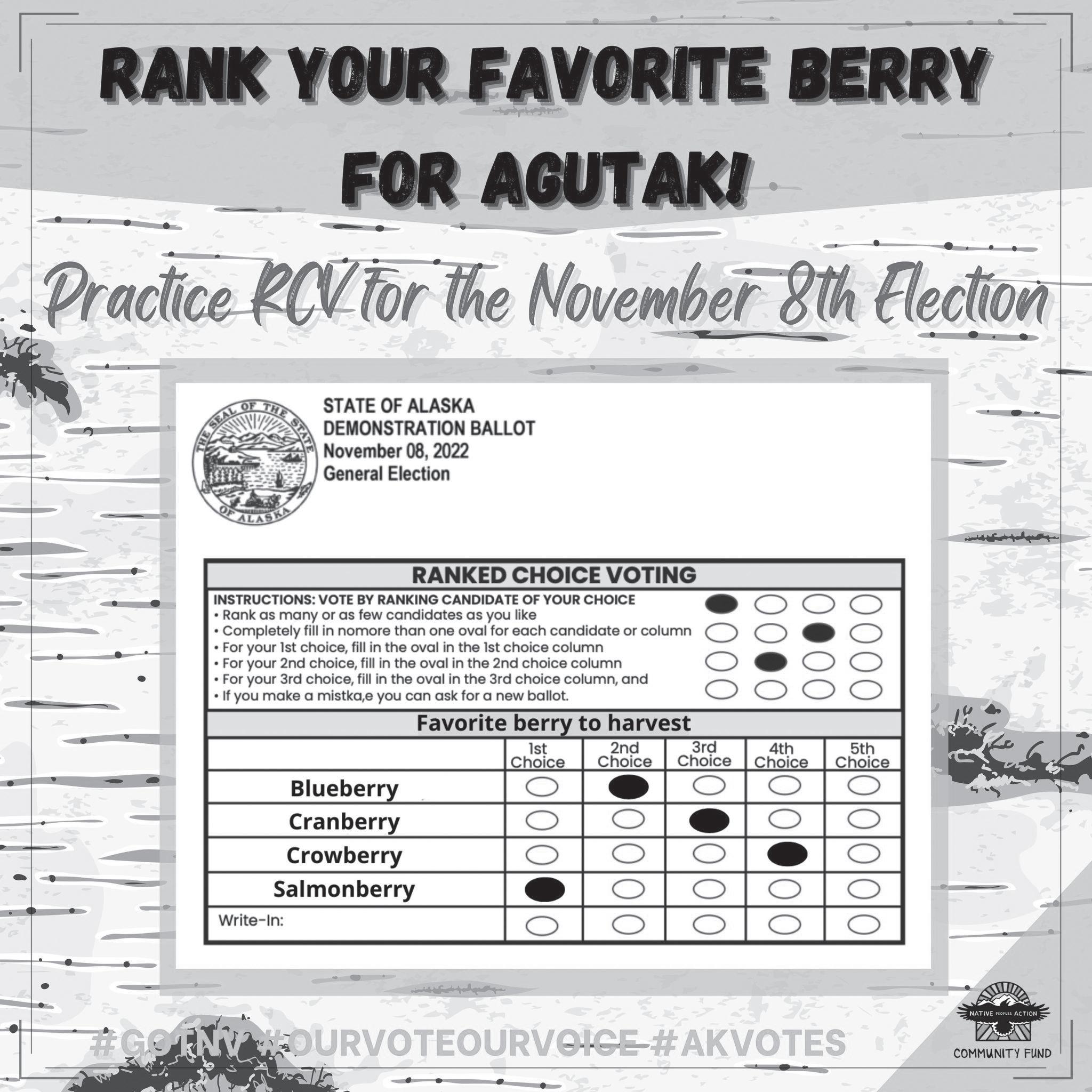
The head of some of Anchorage’s most iconic restaurants isn’t the type of pin-striped businessperson many would expect.
By Mark Zimmerman
Contributing writer
The head of some of Anchorage’s most iconic restaurants isn’t the type of pin-striped businessperson many would expect.
At the Hotel Captain Cook’s quintessential in-house coffee joint, The Cubby, I sat down with restaurateur Laile Fairbairn — owner of the organization that manages Snow City Cafe, South, Spenard Roadhouse, and Crush Bistro. She built Anchorage’s more urbane breakfast scene from the ground up over 25 years. Fairbairn has been through unimaginable changes in her career. And it all started, as anything does, with family.
First Steps
“I came from a big family, and all you did was eat together,” she said of her passion for food, “I mean, that just seemed like the center of everything was eating together or planning your next meal together. And so it was community I loved more than the food itself.”
After graduating from West Anchorage High School, Fairbairn pursued a major in journalism with a public relations emphasis at the University of Oregon. Afterward, she started a career in advertising in Seattle. While residing in the Northwest, she grew accustomed to the lively and hip breakfast scene of the West Coast. In five years’ time, however, the young professional began reflecting on the love she had for her hometown.
“I really loved Seattle, but I missed Anchorage, I missed the connection,” she said, “I liked running into people in the grocery store.”
Another important factor placing Fairbairn back in Anchorage was meeting her future husband — a California transplant up from Los Angeles — while she was in town visiting family. He ultimately prompted a permanent return. A new chapter of her life was ready to be written.
A Long Road Ahead
While reestablishing herself in Anchorage, Fairbairn started accruing the very experience she would need for her
later ventures.
“I had worked at Diane’s restaurant — which is a little cafe downtown — because my soon-to-be husband knew the owners, so I worked there for a couple of months,” she said in recollection of her first job after moving back.
After working for a year and a half at another local ad agency, she had her first taste of food-service managerial experience with the help of an old friend.
“I did work at Humpy’s, because my high school friend owned Humpy’s, and they hired me as their first manager.”
Fairbairn made note of just how formative Humpy’s was, saying: “That was the last job I had before I [opened] Snow City, and they were very supportive of me and knew that was my ultimate goal.”
Drafting a business plan in 1997 with the emphatic support from her peers, she pushed ahead with this ultimate goal. After a long battle over the location that would become Snow City Cafe, she finally had a foundation — albeit a rocky one — upon which to build. From a recently derelict pizza joint, a new adventure unfolded.
A City in the Kingdom
“I opened Snow City, February 10, 1998,” she said, “On February 9, my
whole family came down and cleaned it. And then we reopened the next day and we made chili from a can because that’s what [the pizza parlor] had.”
Though her family provided love and support in droves, that grand opening quickly proved disappointing. With Harvey, the one cook she had on staff, her new restaurant made a total of $330 in sales before the day’s end.
“That first day I remember thinking: ‘Oh my God, how is this ever going to
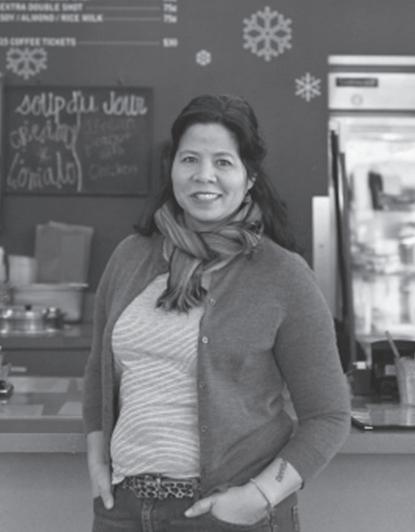
This is an experimental recipe with the base of a mixed berry cobbler inspired by creating an alternate Thanksgiving dessert. Note: it is gluten-free but can be altered.
By Carlee Rizo arts1@thenorthernlight.org
It seems that this time of year it is all about pumpkin recipes or how to make the best Thanksgiving turkey. But from year-to-year, there isn’t much variation on the classic dishes. Perhaps it is time to take a chance — and possibly impress your family — with your newest dessert: mixed berry cobbler. But, It doesn’t have to be just any mixed berry cobbler, you can make it your own.
My husband Zach and I are “experimental bakers” in the sense that we don’t usually follow the recipe. It is often us suggesting, “You know what would make this better?” Since I’m gluten-free, recipes that shouldn’t be gluten-free are often a little bland, so we need to spice things up.
This mixed berry cobbler recipe is a holiday take on what can be a mediocre dessert. It pairs the base of a cobbler with berries — the ones you might still have in your freezer from the last berry picking season — and a dash of cinnamon that gives it a warm autumn flavor.
My mom would usually make cinnamon buns for breakfast on Thanksgiving day, but I couldn’t have any, so I might have a slight obsession with adding cinnamon to recipes, even my hot chocolate.
Zach adds powdered sugar on top of almost every baked good that he makes which gives the cobbler a snowy presence for the month of Novembrrr.
Don’t forget to pair your cobbler with your favorite brand of vanilla ice cream. It adds a creamy element that gives the dessert balance; it’s so easy to make. Don’t just take this from me: Try it for yourself and wow your family with a de-
licious surprise at the holiday table.
Mixed Berry Cobbler (Zach and Carlee Christensen Edition)
For gluten free cobbler
Preheat the oven to 375.
For the mixed berries
2 cups of mixed berries
2 tablespoons of sugar
A key to making sure that all the berries are baked equally is to quarter the strawberries so they are the same size as the rest of the berries. You can use frozen berries — if you have blueberries or raspberries from berry picking season, those would make a great addition — but you have to defrost them first, or you can use fresh berries. However, they are not in season so frozen may be best.
Mix in the 2 tablespoons of sugar with your mixed berries in a small bowl. Make sure you have enough to cover an 8x8 pan.
For the crust
Dry ingredients
1 cup of gluten free flour
2 teaspoons of baking powder
1/4 cup regular sugar
1/4 cup brown sugar Cinnamon Oats
Wet ingredients
1/3 cup melted butter
1 large egg
Simply whisk together all your dry ingredients in a large bowl. You can decide how much cinnamon and oats you want to add if you are following this recipe or add something else. It is called an experimental recipe for a reason. We added a few dashes of cinnamon and about a little less than a 1/4 cup of oats to our dry ingredients. After you have mixed the dry ingredients, set it aside.
Mix together your melted butter and your egg in a small bowl. Tip: Wait for the butter to be cool to add your egg. Once mixed, add your wet ingredients to your dry ingredients and lightly fold them together until you get your dough.
Get out your 8x8 pan and evenly cover the bottom of your pan with the dough. Save some for a second layer on top. Pour your mixed berries on top, covering the bottom layer. Zach suggests adding powdered sugar at this step to bring the flavor
of the mixed berries out. Finally, add your second layer on top of the berries. This will add a crispy element to your dessert that pairs well with the moisture of the first and second layers. We did it in patches so the berries would come through. We topped the cobbler with brown sugar and baked it for about 25 minutes or more. It depends on your oven — ours is a little off but it does the trick.
Once the top is golden and crusty, it’s time to take it out of the oven. Sprinkle the top with powdered sugar and you’re done. Served best with vanilla ice cream.
There are lots of ways to alter this recipe. If something doesn’t seem right, try adding more dry ingredients or wet ingredients depending on what the issue is. The first time we made this dessert, we didn’t prepare enough mixed berries, so that could be one thing to look out for.
Experiment before it’s time for the real deal: Thanksgiving dinner. Happy Holidays!
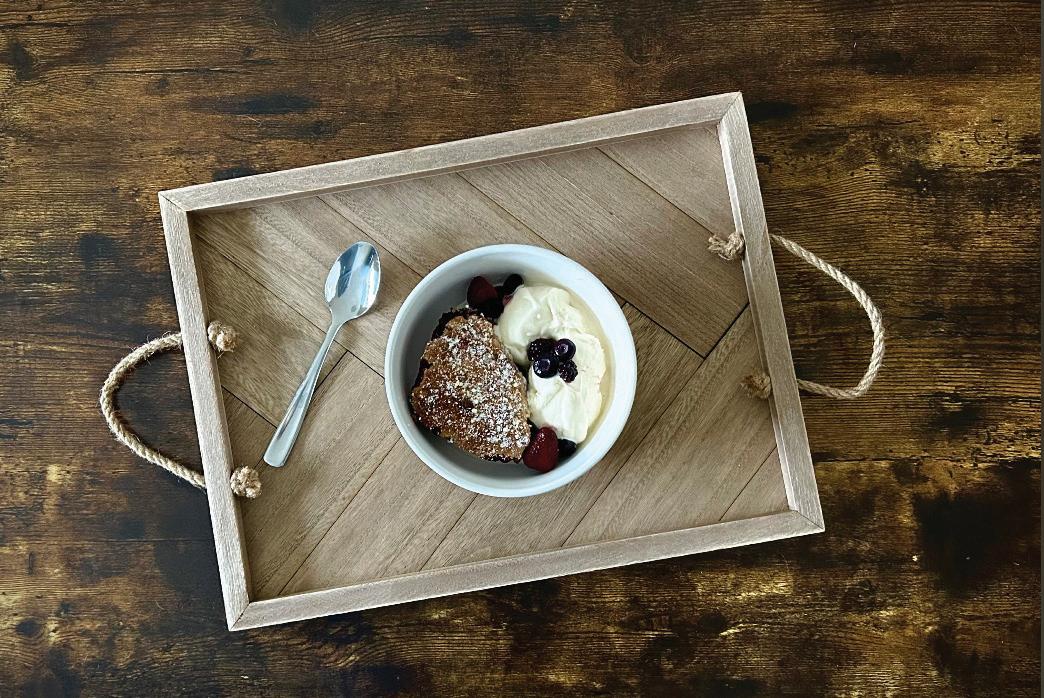
By Jasmine Grant news@thenorthernlight.org
On Saturday, Oct 15, the Raising Canes on Muldoon hosted an adoption fair for puppies rescued by Alaska SPCA Adoption Center.
Tara McCoy, the Adoption Center Manager, said Raising Canes’ corporate reached out to SPCA via email to pitch this joint event. With a radio host, prize raffles and puppies, McCoy thought the event was a great way to get the Anchorage community involved.
The restaurant’s dedication to animal advocacy comes from the owner’s love for dogs a Raising Cane’s representative. The founder and CEO of Raising Canes, Todd Graves, named the company in honor of his own yellow labrador.
He originally considered calling it “Sockeye” as a nod to the Alaskan salmon he caught during his time in the state as a commercial fisherman, according to their website. In the last thirteen years, Raising Canes has “donated more than $850k back to local no-kill pet welfare organizations and other pet welfare organizations.” The restaurant has hosted events such as Saturday’s with affiliate partners, including the SPCA and AdoptA-Pet, in various places around the U.S.
Alaska SPCA’s animal shelter usually hosts five to nine dogs at a given time, said McCoy.
“We work pretty hard to get their information out, put them on social media
and update the website. We get a lot of foot traffic.”
They partner with other organizations such as PAWS of Nome and BethelFriends of Canines to help place animals in homes. Many animals with medical cases are received from animal control to be treated by doctors in the SPCA Clinic, and most of the stray animals received by the shelter come from villages, said McCoy.
Dog birth rates in more rural areas can be much higher due to lack of access to neutering and spay services. Sometimes the only measure of population control villages have is putting down animals.
According to an article published in KTOO, shooting sick dogs has been a common practice in villages like the Yukon-Kuskokwim Delta. In 2020, Tuntutuliak received help from the nonprofit Bethel Friends of Canines to vaccinate 50 dogs and funding from the Alaskan Animal Rescue Friends to transport “28 dogs to Anchorage or Bethel for adoption,” KTOO reported.
McCoy said animal welfare and rescues across the country are struggling with rising homelessness of animals.
“Coming out of COVID a lot of people are going back to work and maybe can’t care for their animals anymore.”
According to the Humane Society, there are an estimated 70 million homeless animals in the United States, and only a small portion of them ever make it to a shelter. Even fewer get adopted into

permanent homes. The easiest way to aid shelters in this fight is by volunteering or donating. Anyone 18-years-old or older can volunteer at
By Carlee Rizo arts1@thenorthernlight.org
There are so many important issues that are not being discussed where we are dealing with life or death. Well, someone is starting the conversation about alcoholism and the grief of parents who lose a child.
Suraj Holzworth lost her daughter Sierra Parker to alcoholism this year and decided to share her story.
Sierra was an artist who created passionately. She used her art as a beautiful form of her own expression and was a creative genius, said her mother. She channeled her energy into all sorts of mediums such as ink, watercolor, acrylics, digital design and illustration.
Sierra learned her passion for art from her mother. Holzworth said, “I’m an artist myself and from a very young age I gave her tons of boxes of art supplies, and she and I would really spend all our time bonding through art. She started doing art when she was 2 or 3 years old.”
Art was the passion of Sierra’s life. She continued on her artist journey at a university in Australia and lived abroad for 6 years. But she came back home to Anchorage and showed the community her passion.
“She worked in Anchorage
as a graphic artist for Microcom and then had her own freelance business as well called Spade Heart Arts and worked for a lot of different clients from around the world. We run a nonprofit organization, so she was our main graphic artist doing all the art for our foundation as well as other organizations she donated time to throughout Anchorage.”
Sierra had a charitable heart, volunteering with eight organizations in Anchorage, but Seeds of Change had to be her favorite.
“When she took her wings in January, just a few months later, I called Seeds of Change and explained what happened and that I would like to do a fundraising art show in her honor.”
Holzworth and Seeds of Change, along with other organizations have all been working together on creating an art show that will be presented at the Power Center on Nov. 4 from 5 to 7 p.m. All the artwork was created by Sierra throughout her life.
Funds will be raised for the Seeds of Change, a section of Alaska Behavioral Health.
The purpose of this show is to raise awareness of mental health issues in youth, particularly substance addiction and to help youth know that they have other options for when life gets a little too much.
“Alcoholism is the most
masked over problem in our culture. It is so promoted in everything and every place and every movie as a way of coping. It only masks the problem; it doesn’t solve the problem. There are more functional ways to detract from what’s going on, whether it be anxiety or trauma.” said Holzworth.
A specialist at Providence hospital informed Holzworth that they’ve seen a 60% percentage rise from 2018 to 2022 in the number of people between the ages of 26 and 33 that are getting cirrhosis of the liver.
If Sierra would have gotten help sooner, she probably would have been a candidate for a liver transplant, said Holzworth.
“But we can’t go back in time. We can all say would’ve, should’ve, could’ve, oughta, but it’s for young people to get the sobering news that this isn’t the solution.”
Organizing this art show meant so much more for Holzworth. “It’s one way that I can deal with a broken heart and try to save other parents from my nightmare,” she said.
Holzworth shared with me that this has been her path of healing though there is little help for grieving parents. She said, everyone shies away from grieving parents, worrying of making the situation worse or just not knowing what to say
By Carlee Rizo arts1@thenorthernlight.org
The Family, UAA’s LGBTQ2+ social club, presented the very first “trashion show” at UAA on national coming out day, Oct. 11. It spread awareness on a variety of subjects including the environment, repurposing, and creating an inclusive environment.
Mark Zimmerman, the secretary of The Family, said that the purpose of the event was to bring the thrifting and repurposing culture — which is common within their group — to life in a full event. He said that he
hoped it would attract all kinds of people and create an encouraging atmosphere in their club environment.
Guest judge Andrew Gray, who is running for state senate, said that there was a diverse group of people and a variety of participants .Indeed, there was a great turnout for both audience members and models.
Watching the show, there seemed to be a lot of enthusiasm for it. Many people encouraged the models and seemed to be enjoying themselves.
The trashion show was held at the Student Union and it was designed with a red carpet lead-
By Carlee Rizo arts1@thenorthernlight.org
If you think that Austin, Texas is the “Live Music Capital of the World,” then you haven’t heard the musical genius that comes from the Houston band The Suffers.
The Suffers is a misleading name for how you will feel after listening to their mix of feelgood genres. Their gulf-coast soul music is a mixture of reggae, jazz, rock ‘n’ roll, hip-hop and funk that reflect the city they come from.
“[Houston is] filled with lots of culture, our band is multicultural in itself, and so instead of limiting ourselves to one genre, we chose to mix everything that’s within us and inspires
ing to a gateway decorated with trash.
The models walking down the runway sported their creative uses of trash. They used materials such as paper towels, cardboard, and of course, garbage bags to create their runway outfits.
This event was not all about fashion, though. It helped to promote and spread the message of repurposing. “The whole message about upcycling, recycling, and finding new purposes, it’s just a beautiful event,” said guest judge M.C. MoHagani Magnetek.
“We want to have this con-
or do. Holzworth is a therapist and has noticed that even grief coaches don’t cover parental bereavement.
“I have had to do many things for my own process in this journey and one of them is to connect with the thing that we loved most together which is art … I’m having a chance to learn more about her through this even though we see her art all the time, I’ve seen most of the pieces. There’s some
I’ve never seen and that’s been a beautiful discovery for me.”
This exhibit is about more than just the art. It is about the woman behind them. It is about the celebration of Sierra’s life through all of her creative expression.
“She’s my superhero, she’s always going to be my superhero.”

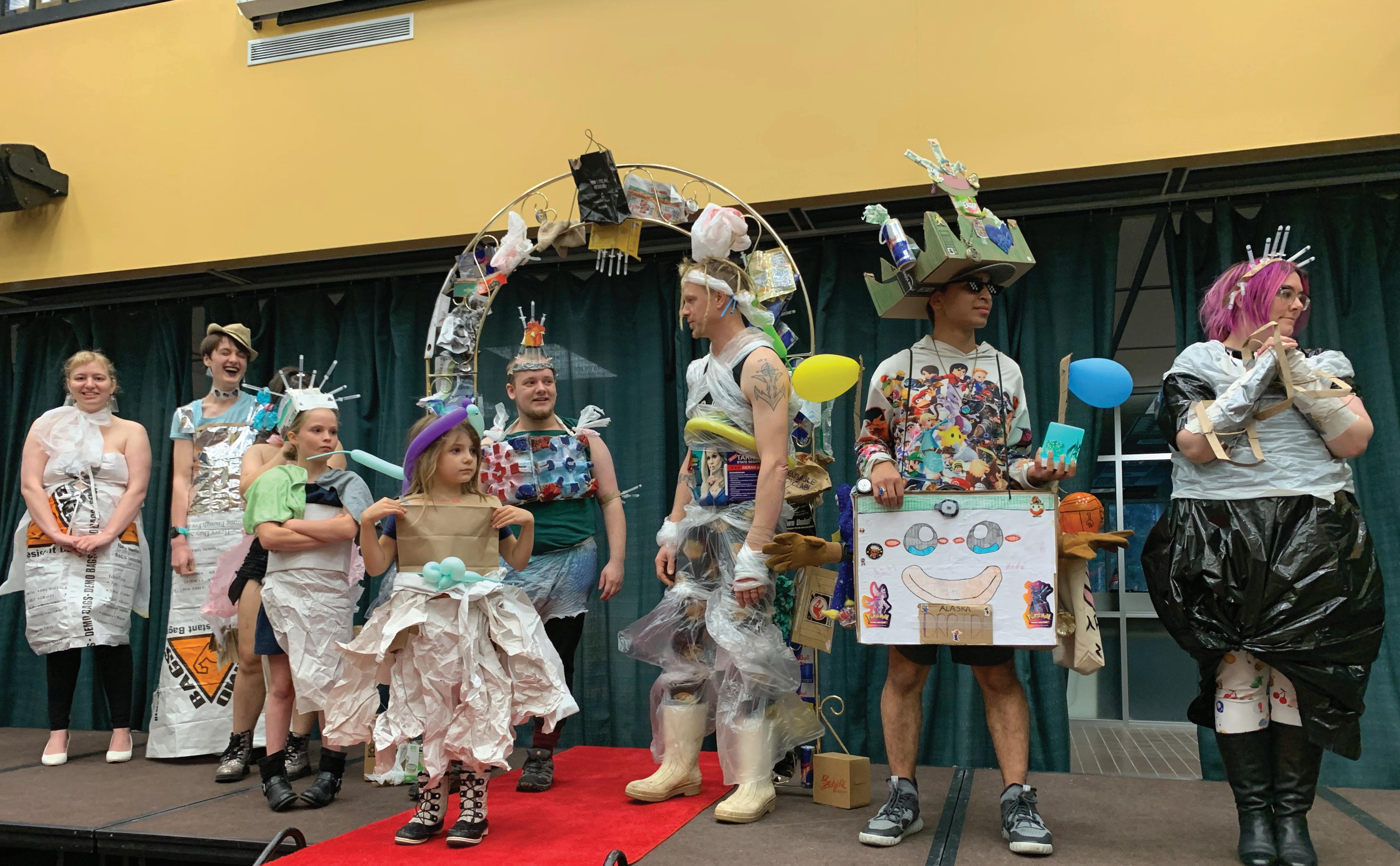
versation about what we are doing with the resources that we have and items that we use everyday that we consider trash.”
There are many ways that this event can be looked at: It is a fashion show; It is an event to spread awareness of waste; It was created to help create an encouraging atmosphere. It accomplished all of these in a fun and engaging way.
us,” said the band’s frontwoman, Kam Franklin.
It’s been a long road for The Suffers since they first started 12 years ago. Their band has changed and has had some challenges. Yet, they have persevered in the face of adversity and have made a name for themselves in the music industry.
“We had a goal to make as much music as possible with the instrumentation that we had. We started off doing more reggae and ska and a lot of folk discouraged us when we first came out, but 12 years later we’re still here.”
The discouragement was in no competition with this group of passionate performers who love what they do. They are still finding people who want to listen to their original music after
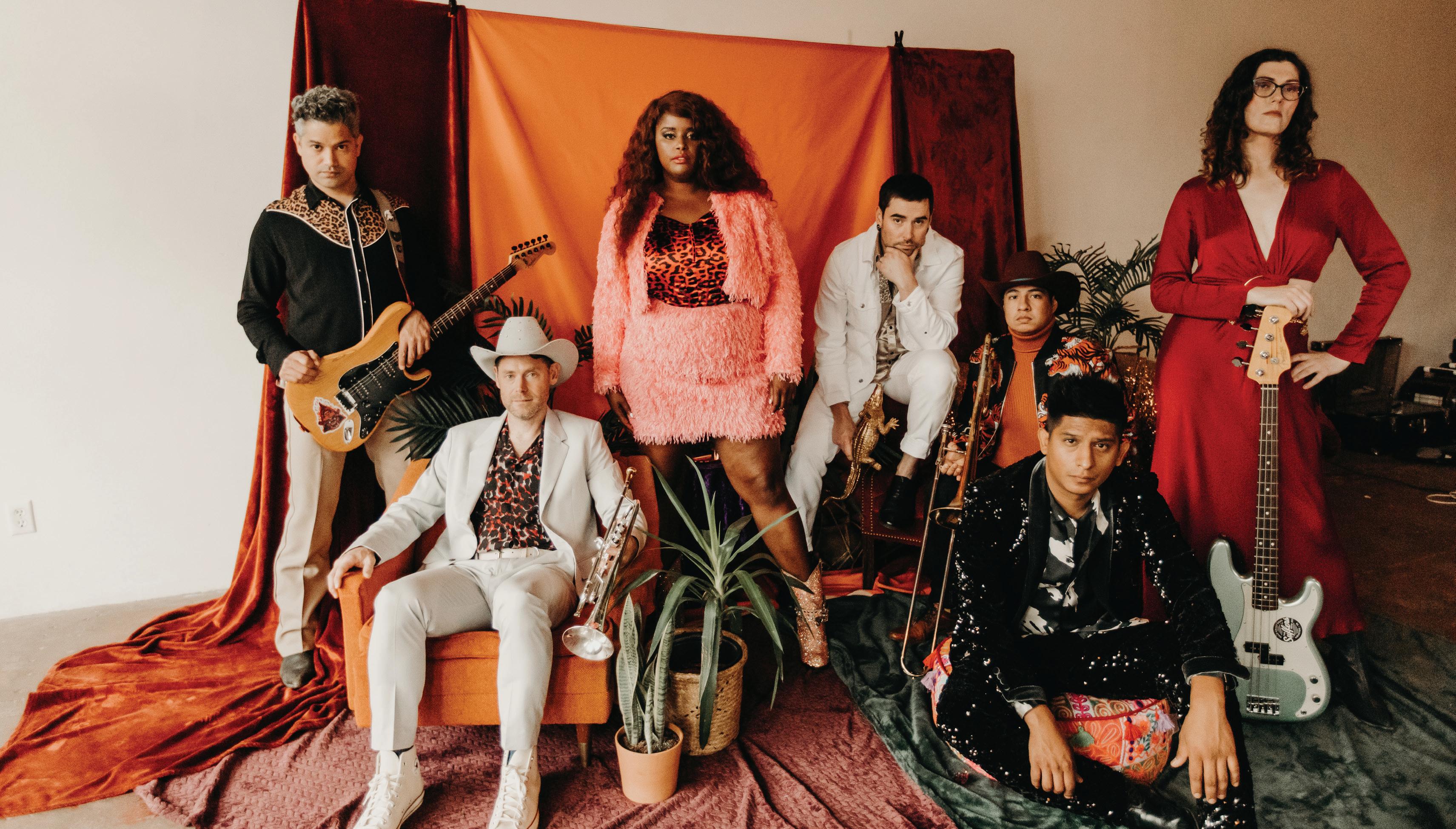
all this time.
The Suffers have been touring since 2015, and they have made notable appearances all around the world. They are about to add Alaska to that list.
On Nov. 5 at the Atwood
Concert Hall, they put on a show that features music from all three of their albums, including their newest studio album released in June 2022, “It Starts With Love.”
“We play a mix of songs from
The Family hosted the trashion show as a way to spread this message that, with luck, will continue to inspire.
all three records and really try to showcase what catalogs us.”
The Suffers will leave you walking away with the positive feelings of empowerment and motivation to live your life to the fullest.
You can watch their newest music video for their new single “Could This Be Love” on YouTube to see what you can expect. It’s a new visual beauty of romantic bliss. “It is meant to show what it looks like to be Black, carefree, and in love. No trauma. No drama. Just love… I hope the video inspires those watching and or listening to find the love that they deserve,” said Franklin.
You can listen to their songs online.
By Carlee Rizo arts1@thenorthernlight.org
A celebration doesn’t seem complete without an enjoyable social activity, such as a dinner, dance, or — as in the case of Filipino American History Month at UAA — karaoke.
To celebrate the occasion, UAA Multicultural Student Services hosted a karaoke night in the Student Union Den.
The event was part of a UAA committee, whose members consist of facul-
ty, staff and students who promote different cultural and heritage based programming.
Quacyya Cuaresma, the engagement and belonging coordinator at Multicultural Services said, “Multicultural Services at UAA is really focused on promoting belonging, connection and community. So that’s exactly what this event did, and I’m happy about the turnout.”
Attending the event were people who wanted to celebrate their history,
along with others who just wanted to join in on the fun.
The people who came turned the karaoke night into an entertaining and lively activity. People seemed to connect and have a good time while cheering on their friends like they were the stars of a concert.
Events such as this, and other casual activities, seem to be popular around campus, and Multicultural Services are looking to host a monthly event such as karaoke or game night
By Carlee Rizo arts1@thenorthernlight.org
The Den had a perfect atmosphere — like a cozy coffeehouse with a homey fireplace accompanied by light background music — for writers from UAA Creative Writing Club to read their work.
That night, the snow could be seen falling through the windows outlined by the industrial architecture. Everyone gathered around to listen and read their stories at what seemed like a writer’s dream retreat.
The event was a collaboration by Understory and the Creative Writing Club. It had many people working behind the scenes to make it happen. Nicole Regan, Taylor Morrison and Taylor Heckart are all co-editors of Understory, and they worked alongside Devin Higgins, the President of the Creative Writing Club.
Heckart said, “We felt that it would be a really good collaboration with the Creative Writing Club
since they’re wonderful folks who output a lot of writing, and we love publishing writing.”
This event had good opportunities for both of the organizations involved. Writers of the Creative Writing Club have the options to submit their work to be published in Understory.
Anyone across UAA can submit as long as you’re taking six credits.
The Understory editors will go through and select pieces of students’ work to be published in the spring, Heckart said. This year’s deadline is December 17th and they are accepting a wide variety of genres. Additional information can be found on the Understory UAA page.
In the collaboration, Creative Writing Club was able to enjoy a more public presence. Higgins said, “I definitely loved having this group. As a Creative Writing Club, we haven’t usually been able to do events like this. We kind of just keep to ourselves, but I did really like to have this opportunity to col-
laborate with another club and have a slightly more public presence.”
Higgins participated in the event by reading their own piece. Their favorite line was the ending, “The final hope that I speak of is you.” It packs a punch and wraps everything up, Higgins says. Indeed, the last sentence seemed to leave a powerful impression.
All of the readers were talented writers and they brought something special to this event.
Understory is hoping to host more events: One during winter break and then one during spring break right before their publication in 2023, but nothing is confirmed yet. It will be at the same location at a similar time, Regan said.
If any club is interested in working with Understory, they can email understorysubmissions@gmail. com. Individuals who are interested in being an editor or part of the team in the future can reach out to Ronald Spatz.
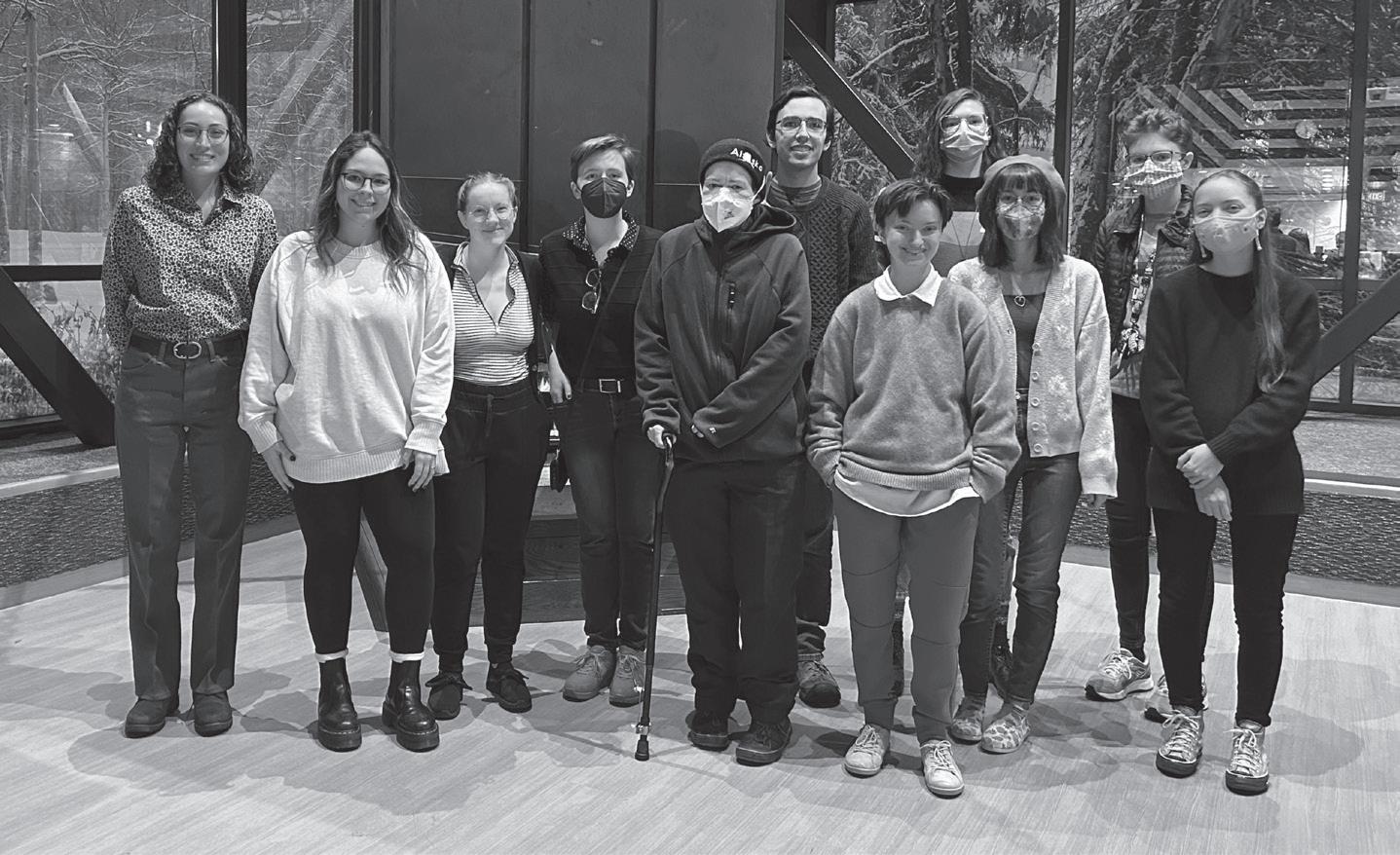
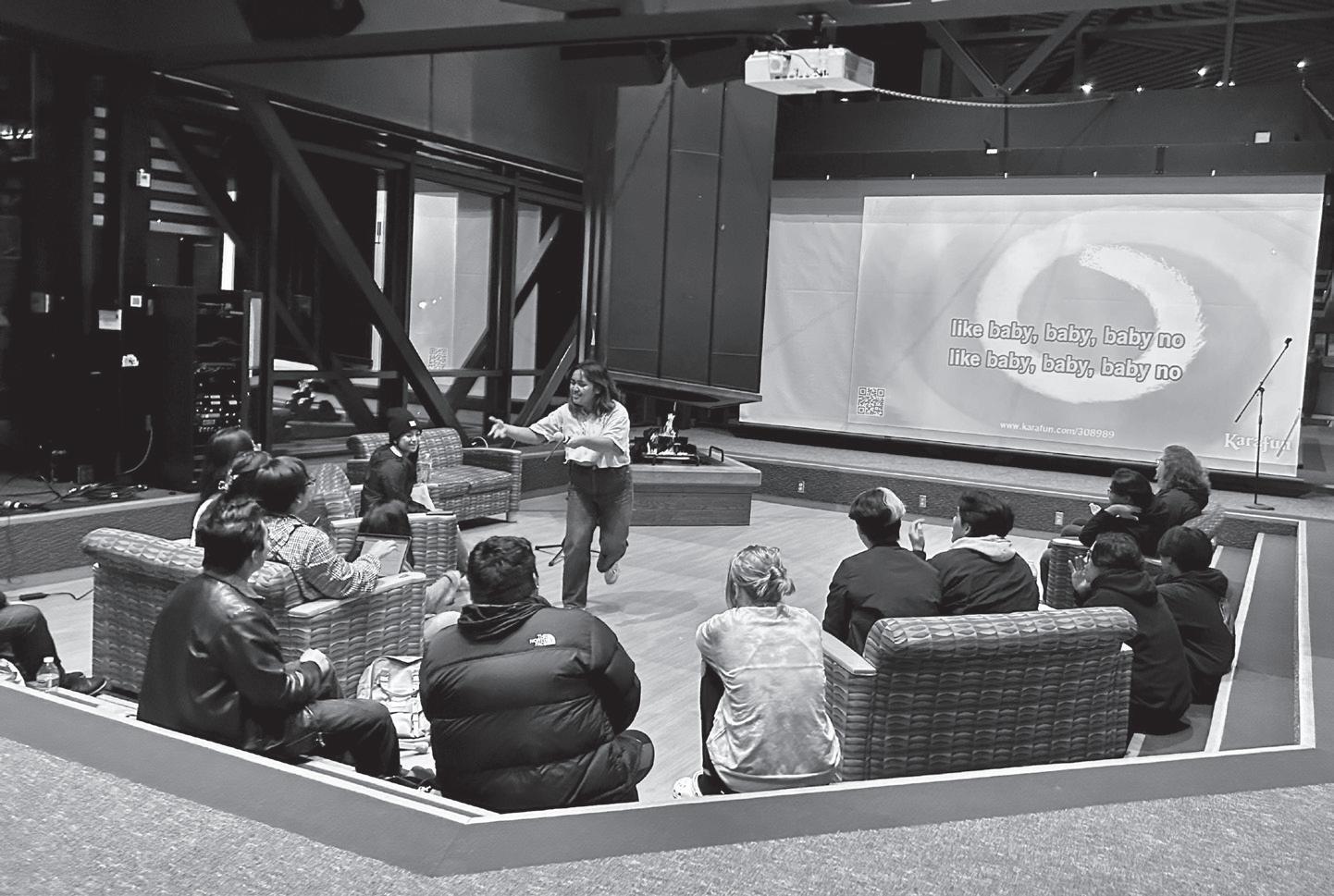
to get people to
By Carlee Rizo arts1@thenorthernlight.org
The 37th annual No Big Heads is being presented in the Hugh McPeck Gallery. This is a national self-portrait competition of limited size. There were over 70 pieces submitted, but only a number of them have been chosen to be included in the exhibit.
Many people attended the opening of the gallery to admire the work and to hear the awards presented by guest juror, Indra Arriaga Delgado. There was a general excitement in the room.
You could hear people around the room making profound remarks about the pieces of artwork. The artists who submitted pieces were present and were posing with their artwork.
Self-portraits are important pieces in the art world. A self-portrait is meant to be an exercise for artists. It helps them get to know themselves better,
but it goes beyond that. They are fragments of how they see themselves or fragments of what they want to be. This is something to keep in mind as you walk through the exhibit and admire their work.
Guest Juror, Indra Arriaga Delgado announced the pieces that received honorable mentions along with two pieces that would be awarded the No Big Heads Exhibit Award and the Juror’s Choice Award.
The honorable mentions included And the World May Never Know by Marc Sirinsky, Blue Me by Angela Liu, The Long Shadow by MaryBeth Printz, Self Portrait in the Bathroom by Delaney Rua and Tea Time by Oceana Wills.
These pieces of artwork are displayed with an honorable mention plaque in the gallery.
Joining them on display is the winner of the No Big Heads Exhibit Award, Myelinated Barf by Cas-
sidy Johnson. This selfportrait helps us face the reality of the prevalence of mental health issues in our community.
Indra Arriaga Delgado says that she selected this piece because of its importance to our community. “So, I felt that it was an important piece … reminding us that there is this thing happening around us that we are all a part of and something that we all suffer from to some degree.”
The Juror’s Choice Award was given to Self Portrait as Spider Woman by Geralyn Montano. This piece featured a self portrait that explored the idea of different faces of oneself. There are faces we internalize and other faces that we show. “There’s an element of otherness that connects you to a bigger community, into a different experience,” said Indra Arriaga Delgado.
The No Big Heads will be on display in the Hugh McPeck Gallery through Nov. 3.
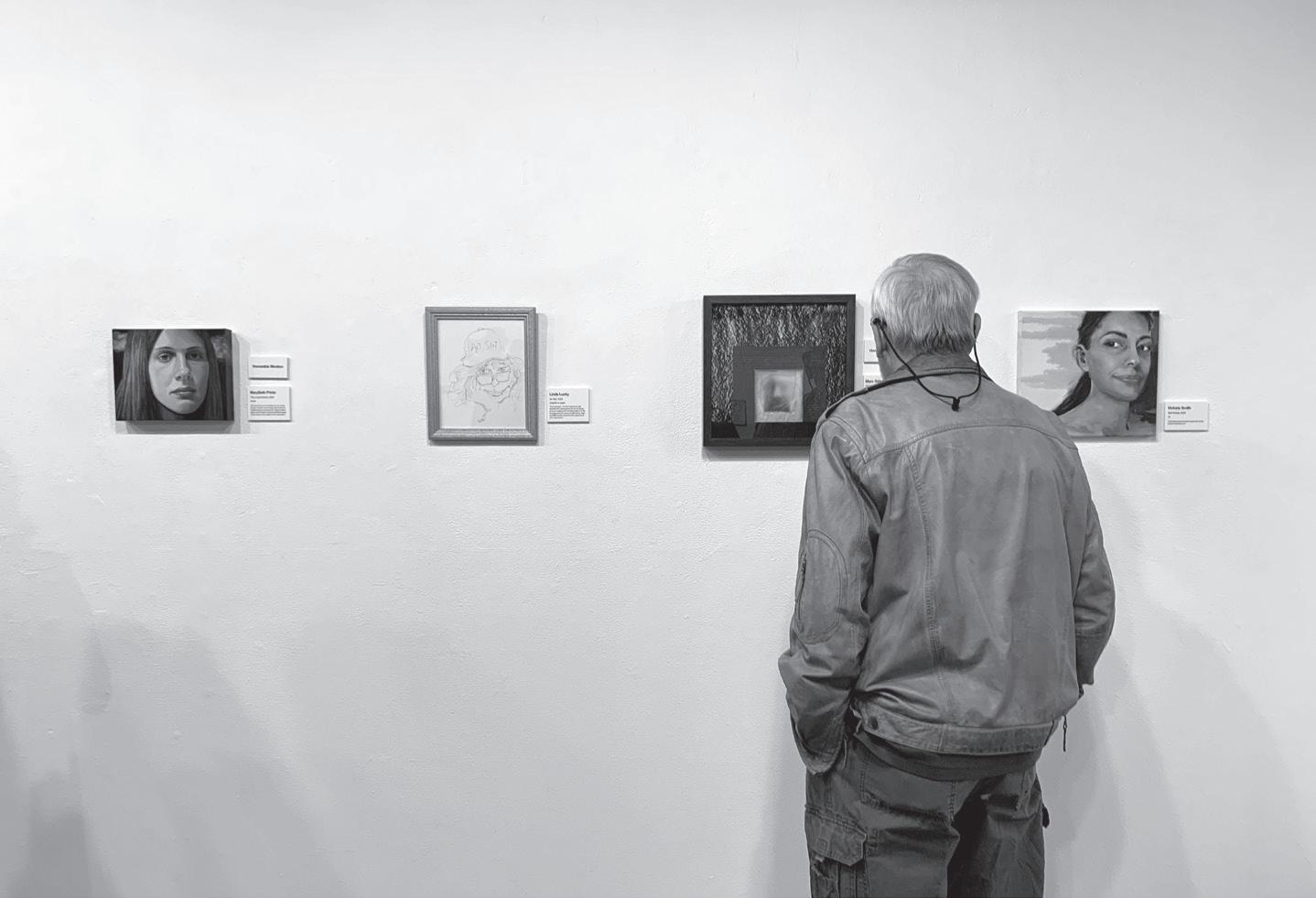
There’s not necessarily spoilers involved with this content, but there are examples used throughout the article from the series.
By Carlee Rizo arts1@thenorthernlight.org
Welcome to the new ABC drama, Alaska Daily, which attempts to be a drama that is half provoking — with an agitational investigative reporter as the lead — and half quirky with a workplace set in an Alaskan newspaper,making it something of a dramedy.
Alaska Daily — written and directed by Tom McCarthy — stars Hilary Swank as Eileen, a disgraced investigative reporter for The Vanguard, a big league publication in New York.
After one of Eileen’s stories goes awry, she loses her position, landing her in Anchorage, Alaska for her redemption. Her former colleague recruits her to work for the Daily Alaskan with an enticing story involving missing Indigenous women. He leaves her with one last line, “For what it’s worth, we need good reporters in the minor leagues too.”
Changing from New York to Alaska, the series
is filled with jokes maybe only Alaskans will think are funny, and the reporters of the local newspaper become vital in Eileen’s character development.
The series largely focuses on how Eileen is this great reporter, however she is not the prime example for what a great journalist should be like. In most of the scenes, she is portrayed as an agitational reporter who is condescending over her coworkers and sources.
Though, credit should be given where credit is due, because she knows how to get things done and is challenging the Daily Alaskan staff to pursue their stories.
They humaize her more as her character develops and give her a new personal struggle of panic attacks.
The Eileen storyline is eventually joined by Roz, the Alaskan Native reporter who will be the turning point in the investigation of Gloria Nanmac’s disappearance. As the episodes continue, it is addressed in the plot line that Roz is going to become less of a
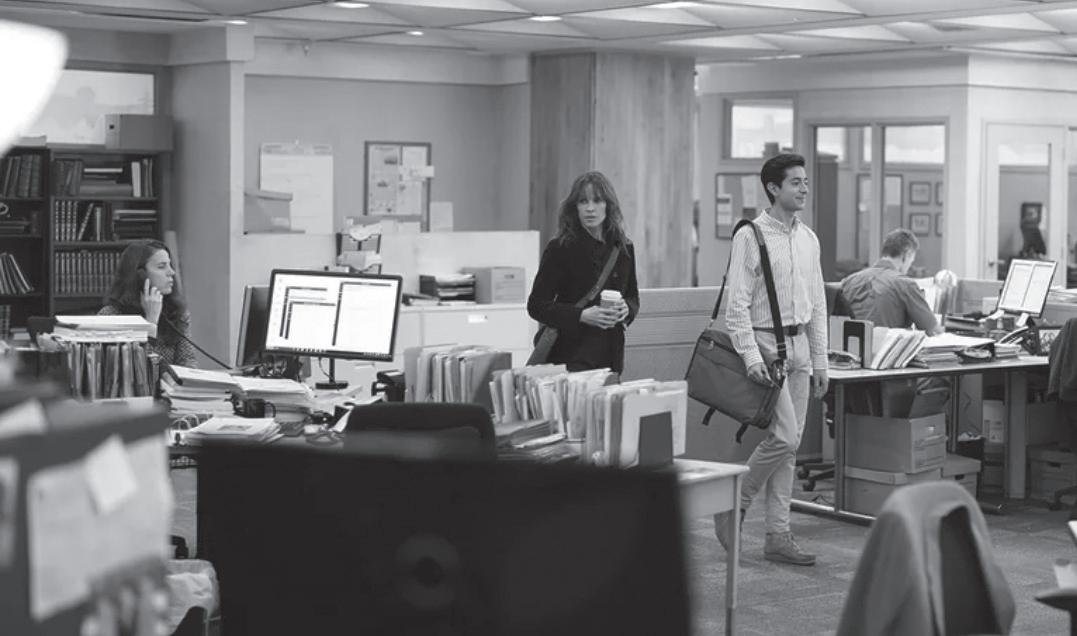
secondary character. She is not the sidekick, she is the partner, the co-star.
In many of the descriptions of the show around the internet, Roz is not featured as one of the main characters. Perhaps that’s about to change.
In a show that addresses the sensitive issue of the disappearance of Indigenous women, having Native actors in key roles is vital in remaining authentic. Luckily, they have a great team of writers who are doing it the right way by putting in the work to support Indigenous peoples. They are able to incorporate culture and address the issue of the system, particularly in
Alaska, failing Indigenous women.
After basically binge watching the first three episodes, it seems like it’s not fully developed yet. They have the tones of a drama and a comedy working against each other throughout the episodes. One second you are in an intense investigation of Gloria Nanmac’s mysterious disappearance, and then the next you are back in the quicky office with their own secondary storylines.
Luckily, the show does not exclusively focus on Eileen’s character development. The other reporters that are local get
By Carlee Rizo arts1@thenorthernlight.org
DaVine Music Studio opened a rehearsal space on Oct. 15, and, to introduce it to the community, they hosted a jam session. Musicians from all around Anchorage came together to do what they love. It was a night that saw a celebration of music.
The Texas style jam session where musicians could jump in and add their talent to the vibe was a collaborative musical experience.
The space is two rooms: a dance floor with mirrors lining the wall and a soundproofed room to play your instruments. It is located at 100 Muldoon Road, suite 125.
If you are a musician in the area, you may have noticed how difficult it is to find a space to rehearse and not break your pocket in the process. Especially if you play drums like Sarah Felder, one of the owners of DaVine Music Studio.
“I realized it was very hard to find space for myself to practice personally… When I found this place I was really just looking for myself and my band to practice.”
It started out with the struggles that musicians
face of finding a space to develop their talents. Felder made it into so much more alongside her business partners.
“We really want it to be a music hub also because
we’ve noticed that a lot of the different sections of the music community like jazz stays in one cliche, the R&B soul stays in another, the rock people are over here, reggae is over
here.”
This space is being designed as a place for all musicians, whether jazz,rock or something else. Felder says that the hope is to come together
featured covering at least one semi-Alaska specific stories, such as the local diner being bought by a burger chain or a scandal of a fictional local politician.
It is these small storylines that focus on the importance of local journalism and provide thought provoking commentary on the struggles of smalltown newspapers.
Not only are these stories discussing something important, but the characters who are writing them are humanizing journalists. You often see the journalists at work, but there are scenes of them being more than a journalist. They have fami-
and build a whole music scene here in Anchorage.
This inclusivity is being promoted by DaVine Music Studio by hosting an open mic every Thursday night.
“I don’t think there’s a lot of that going on either where the music community can really grow and build and you know, come together on a regular basis so I would love for that to
lies that they talk to about their struggles at work and they face the extraneous comments of public antagonists, which take a toll on them and leave them questioning why they do what they do. Each character has a chance to answer this question for themselves. Some don’t quit because they are not ready to give up on the paper or Alaska. Some don’t quit because of a personal struggle.
The series stops being about the professional side of journalism and changes the conversation because that’s how we connect. Even Eileen says, “This job isn’t easy. We don’t do this job to be liked, we do it because it matters. This story is important, especially to Alaskans. The other major publications around the world aren’t going to cover it. That’s why local journalism matters.”
Alaska Daily goes deeper than just your average office TV series. It entertains while informing on much more serious issues. It’s not only compelling, but it may start to raise conversational questions.
Alaska Daily is streaming on Hulu.
happen here every Thursday from 9pm to 12am.”
DaVine Music Studio is offering a space for creatives whether you need a place to rehearse or you just want to come together with other musicians. Other opportunities such as promotion or entertainment management are available through DaVine Music Studio.
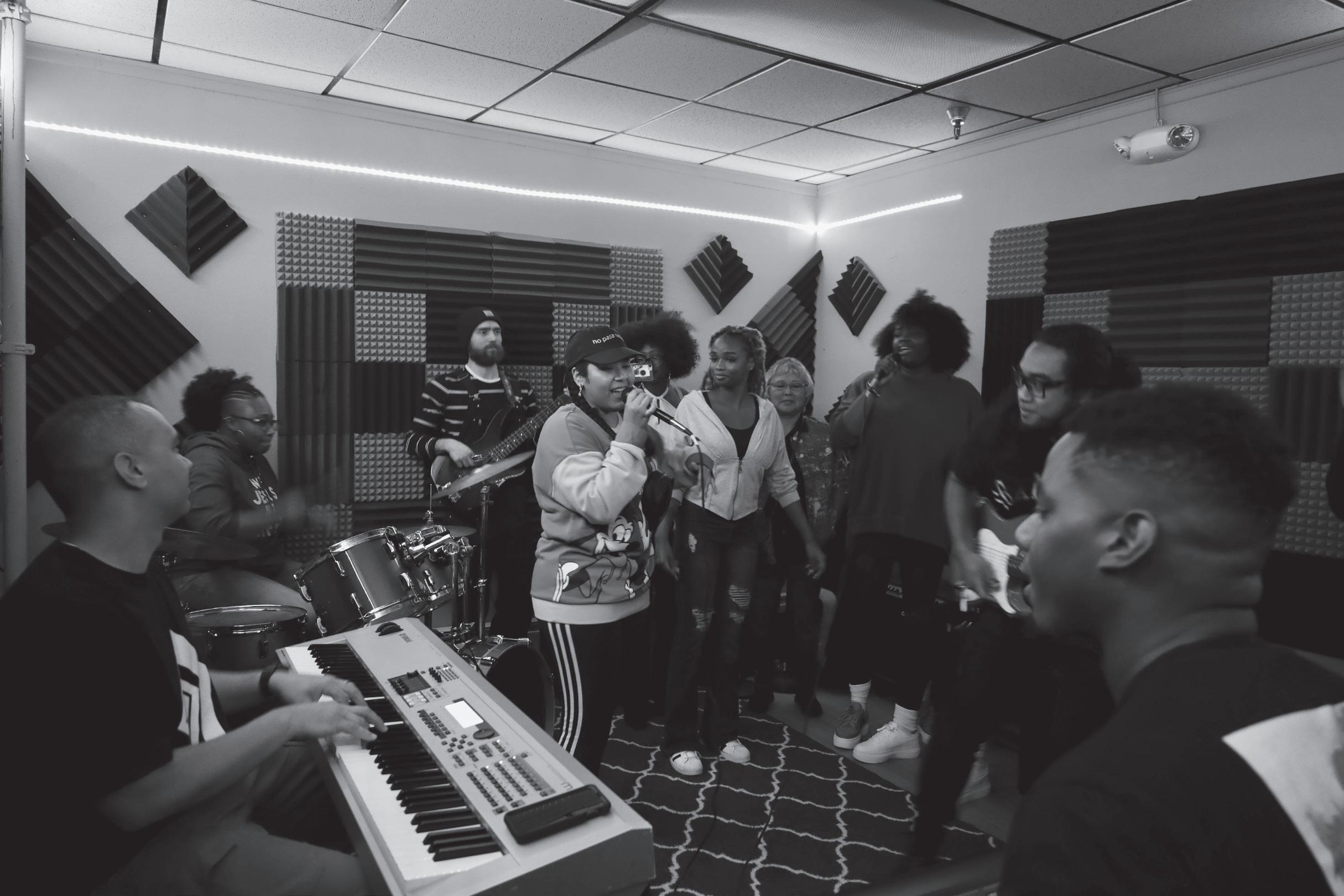
By Avery Williamson sports@thenorthernlight.org
The Seawolves defeated National Association of Intercollegiate Athletics school Midway University in back-toback games to start their season with a 2-0 record.
In the first game of the series, the Seawolves trailed 4-3 in the opening minutes. They then took control of the game with back-to-back three-pointers from Tyson Gilbert and Da’Zhon Wyche to start a 14-5 surge.
UAA continued to expand their lead, and Caleb Larsen nailed a three-pointer to push the lead to 25-14 with eight minutes left in the first half. The Seawolves entered the locker room for halftime with an advantage of 41-30.
Midway kicked off the second half with a short jumper, but they remained scoreless for the next few minutes as the Seawolves went on a 9-0 run. UAA continued to push their lead to 71-45 after a putback layup from Jaron Williams. The Seawolves won the game 87-63.
“I thought we performed well for such a new squad,” said UAA head coach Rusty Osborne. “We moved the ball well and showed good balance. This was a positive start to a long process, and we’re excited about our outlook.”
Jaedon Bradley led the team in scoring with 19 points, and Wyche added
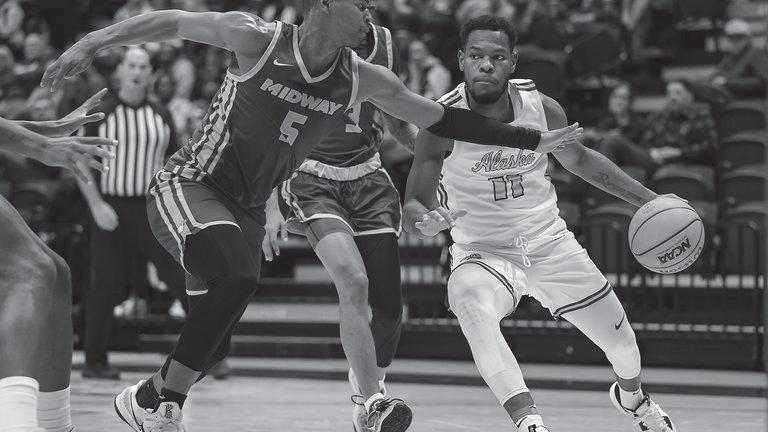
12 more points to the Seawolves’ stats.
Gilbert, Vojtech Ruzek and AJ Garrity each scored nine points, Larsen had eight points and Lachlan Viney contributed seven points, six rebounds and five assists.
Gilbert, a transfer from Colorado State University Pueblo, made his Seawolf debut against Midway. Gilbert had missed the last two seasons after the 2020-21 season was canceled because of COVID-19, and he had to sit out of the 2021-22 season because of an achilles
By Avery Williamson sports@thenorthernlight.org
The Seawolves put up a strong fight against NCAA Division I school UC Irvine on Nov. 3, forcing the Anteaters into overtime with help from Da’Zhon Wyche’s 32 points. Despite their strong effort, the Seawolves fell short and lost the game 83-87.
Things looked grim 14 minutes into the first half, as the Seawolves trailed 16-27. However, the team didn’t give up. They outscored the Anteaters 9-2, to get the game within four points before halftime.
UC Irvine returned to court hungry for a lead. Within ten minutes, they stretched back to a 46-37 edge over the Seawolves. UAA then responded with a 13-4 run. They tied the game after a steal from Wyche, who found Dathan Satchell for a jumper.
The game remained within one or two possessions for the rest of regulation. The Seawolves grabbed a 67-62 lead after Jaedon Bradley scored a jumper with three minutes left in the game. Wyche put UAA up 69-65 with a little over one minute left in the game, but UC Irvine’s Dean Keeler and Dawson Baker both scored in the final minute to forge overtime.
The Anteaters scored on the first possession of overtime and didn’t trail for the rest of the game. They shot 4-of-5 from the field and 9-of-10 at the freethrow line. Their impressive clutch shooting led them to an 87-83 victory.
“I thought we showed a lot tonight, playing with toughness and battling for 45 minutes,” said UAA coach Rusty Osborne.
“We made huge strides defensively the last week, and it paid off. Offensively we were out of sync and not trusting our offense in the first half, but we settled in and had a good offensive second half.”
While the Seawolves faced a tough loss, Osborne saw it as a moral victory. “It is tough to lose, but we have very little installed after only 12 practices. As we get more practice opportunities, we will be better prepared in many areas,” said Osborne.
“Da’Zhon had an expectation game, of course, but others played well also. In his first game, Dathan showed his ability to shoot, and Jaedon, Jaron and Tyson Gilbert all had good games. Sawyer Storms battled bigger guys all night long and AJ Garrity gave us great minutes at multiple positions.”
Satchell finished the night with 11 points, Bradley and Jaron Williams each with 10, Storms with 9 and Gilbert with 8. Storms also had four rebounds and four assists, and Gilbert secured four steals.
The Seawolves play their first conference games of the season against fellow NCAA Division II opponents in a tournament in Hawaii. The tournament kicks off on Dec. 11 at 12:30 p.m. Alaska Daylight Time when the Seawolves face off against Chaminade University. Visit GoSeawolves.com for live links and stats.
tendon injury.
“It was great to finally see Tyson back on the court,” said Osborne. “He’s worked so hard to get back to this point, and we’re thrilled to finally have him contributing out there.”
The Seawolves returned to the court the next day hungry for another victory. Midway didn’t make it as easy for them this time, though. The opposing team led for the opening minutes and didn’t let UAA run away with the game.
The Seawolves found themselves tied
37-37 with a few seconds left in the first half after Midway made 11 of their last 16 shots. Before the buzzer though, Wyche connected with a wide-open Garrity at the three-point line. Garrity released the ball a second before the halftime buzzer and nailed the shot. The crowd jumped to their feet and cheered the Seawolves into the locker room with a 40-37 lead.
UAA held onto their lead throughout the second half but couldn’t shake Midway off their backs. With eight minutes left in the game, Midway’s Will VanHook cut his team’s deficit to six points with a putback shot. The Seawolves didn’t let this faze them, though. Instead, Wyche passed up the court to Sawyer Storms on a fastbreak. Storms then dunked the ball, which got the whole crowd on their feet.
After Storms’ dunk, the Seawolves went on a 11-0 surge to lead 77-60 with four minutes left in the game. UAA continued to outscore Midway for the final minutes and won the game 87-65.
“We experimented a lot with our lineups tonight, trying to see how different groups played together,” said Osborne. “Once we went back to a more traditional substitution pattern, I think we responded well to close things out.”
The Seawolves got double-figure scoring from six different players. They were led by 19 points from Storms, followed by 14 points from Wyche, 13 points from Viney and Gilbert and 12 points from Bradley and Williams.
The Seawolves return to the court on Nov. 3 at 6 p.m. Alaska Daylight Time in an exhibition game at NCAA Division I school UC Irvine in California. Visit GoSeawolves.com for live links and stats.
By Avery Williamson sports@thenorthernlight.org
The Seawolves lost both games against the Air Force Academy Falcons in Colorado Springs, Colorado. UAA fell short 3-5 on Nov. 4 and 1-3 the next day.
The Seawolves found themselves down 0-3 early in the first period. AFA took advantage of its first power play of the game three minutes in, and then scored twice six minutes later.
Desperate to stay alive, the Seawolves rallied to get back into the game. Four minutes after AFA’s goal, Caleb Hite scored the first Seawolf goal of the game with a backhand shot that tricked AFA’s goalie. Derek Hamelin assisted on the goal. Three minutes later, William Gilson ripped a wrist shot to decrease AFA’s lead before the first intermission.
The second period featured six total penalties between the teams. Both teams played tight defense to keep the period scoreless until the final two minutes, when AFA’s Clayton Cosentino got past the defenders to score a long goal.
The Falcons kept their 4-2 lead throughout the third period until the Seawolves pulled the goalie with just over three minutes remaining in the game so they could have another offensive player on the ice. This strategy proved successful when UAA’s Jamie Collins scored a goal, which was assisted by Hite.
With 45 seconds left in the game, AFA got past the Seawolves’ defense to score an easy empty-net goal. The Falcons won the game 5-3.
UAA finished 0-for-4 on the power play and AFA was 1-for-7. Seawolf goalie Joey Lamoreaux made 24 saves in the first two periods. Nolan Kent then took Lamoreaux’s spot in the goal and finished with three saves.
The Seawolves returned to the ice the next day to face off against the Falcons
again. This time, UAA took an early lead in the game after Matt Allen scored with a low-angle shot seven minutes into the first period. Hamelin and Brett Bamber both assisted on the goal.
The Seawolves couldn’t prevent AFA from scoring, though. Eight minutes into the second period, the Falcons tied the game 1-1. The opposing team then took the lead four minutes later with a shot that went between Kent’s legs.
Down one point late in the third period, the Seawolves pulled their goalie with hopes of scoring. However, their strategy didn’t work this time. AFA played tight defense and capitalized on the empty-net, scoring the last goal of the night with 24 seconds remaining in the game. The Falcons won the game 3-1.
Hamelin’s assists in both games against AFA extended his point streak to six games. UAA will return to the ice on Nov. 11 and 12 to take on Arizona State in Tempe, Arizona. Visit GoSeawolves. com for live links and stats.

final rally. NNU’s Oliva Wright delivered a kill to tie the game 22-22, but the Seawolves responded with consecutive kills from Isabel Evans and Leilani Elder to win the frame 2522.
way had 10 digs and three assists.
22 and win the game 3-1.
“I thought our serving game was good tonight, and that’s what allowed us to finally get some momentum in the final sets,” said Green. “Even when we weren’t getting aces, we were making it difficult for them to get into their offense.”
The Seawolves returned to the court on Nov. 5 to take on the Central Washington Wildcats. Floyd and Stephens delivered huge efforts to help propel UAA to a 25-20, 28-26, 25-22 victory over the Wildcats in front of the largest regular-season crowd – 3,888 people – in NCAA Division II volleyball history.
Payne to make it 24-22.
as well.” With their victories over Northwest Nazarene and Central Washington, the Seawolves now just need two wins to earn the Great Northwest Athletic Conference title. UAA will have their chance on Nov. 10 and 12, when they will take on Western Oregon and Saint Martin’s on the road. The Thursday game is at 1 p.m. Alaska Daylight Time and the Saturday game is at 4 p.m. Alaska Daylight Time. Visit GoSeawolves.com for live links and stats. Continued from cover:
The Seawolves never trailed in the fourth frame, though the Nighthawks were able to shave a 16-7 deficit to 24-22. On set point, UAA coach Chris Green called a timeout to draw up a play. The Seawolves returned to court and Nicole Blue delivered a kill to win the frame 25-
Stephens delivered 22 kills and had a careerhigh of 20 digs. Jaunet had eight kills, Blue and Evan tallied seven each, and Elder finished with six kills and a team-high of four total blocks. Madison Gallo -
By Avery Williamson sports@thenorthernlight.org
The Seawolves defeated the University of Alaska Fairbanks Nanooks at home in four frames to improve their Great Northwest Athletic Conference record to 13-1. This victory helped the team maintain their one-match advantage over Western Washington in the GNAC standings.
The Seawolves strug-
gled in the opening frame, falling behind midway through. They couldn’t get their momentum back and lost the frame 18-25.
UAA came back strong in the second frame, though. They took off with a 13-8 run and defeated UAF 25-19 to tie the game 1-1.
In the third frame, the Seawolves claimed an early 12-5 lead and maintained a lead throughout the frame. With UAF des-
3211 Providence Drive Student Union 113 Anchorage, AK 99508
Executive Editor
Matthew Schmitz (907) 786-1313 editor@thenorthernlight.org
News Reporter
Jasmine Grant news@thenorthernlight.org
News Reporter
Dylan Flos contributor@thenorthernlight.org
News Reporter
Kyle Ivacic news2@thenorthernlight.org
Features Reporter
Kaycee Davis features2@thenorthernlight.org
Sports Reporter
Avery Williamson sports@thenorthernlight.org
Arts & Entertainment Reporter
Carlee Rizzo arts1@thenorthernlight.org
Layout Editor Zach Christensen layout@thenorthernlight.org
The Seawolves got off to a solid start, erasing a brief 19-18 deficit with a 7-1 run in the first frame. Jaunet had three kills during UAA’s surge and Stephens tallied six of her own. The Seawolves won the first frame 25-20.
The second frame
perate to stay alive, the Seawolves were forced to fight off a Nanook comeback. UAF fought to tie the frame 17-17, but UAA quickly took the lead again.
UAF’s Ella Bines smashed a kill to get her team within one point, but that’s as close as the Seawolves allowed. Eve Stephens and Lisa Jaunet delivered back-to-back kills to extend their lead, and Stephens delivered on set point to help her team win the frame 25-20.
The Seawolves opened the fourth frame with a 8-1 surge and never let the Nanooks get closer than

was a thriller, featuring 17 ties and five lead changes. Back-to-back kills by CWU’s Tia Andaya gave the visitors a 18-16 edge, but Stephens and Evans answered with Seawolf kills. The teams then began trading points. UAA fought off a set point at 2423, and the Wildcats did the same at 25-24 and 2625. The Seawolves finally secured the set 28-26 after getting kills from Jaunet and Stephens.
The third frame was also close, featuring nine ties and three lead changes. Neither team fell behind by more than three points. Tied 22-22, Stephens delivered a kill to take the lead, and then stuffed CWU’s Mariana
15-12. Jaunet and Isabel Evans combined on three blocks to help their team go on a 10-3 run.
On set point of the fourth frame, the whole crowd got on their feet to cheer on the Seawolves. The Nanooks served the ball to the Seawolves, who set up a play for Stephens. As Stephens winded up for a kill, the crowd began to cheer in anticipation. The Alaska Airlines Center erupted into celebration as the ball hit the ground, and the Seawolves won the final frame 25-15.
“We looked flat in the first set, which was unusual for us, but I’m pleased
On set point, all 3,888 people that piled into Alaska Airlines Center got on their feet to cheer on their team. The Seawolves won the set 25-22 after Stephens and Elder blocked another attack by the Wildcats, and the crowd erupted into cheers.
Floyd had 31 assists and a career-high of 24 digs, and Stephens added 21 kills, 13 digs and six blocks to the Seawolves’ stats.
“That was another great effort against a very good team in a pressurepacked environment,” said Green. “Our defense made the difference, especially Ellen and Lisa with some huge digs, and our block
with the execution we displayed over the last three sets,” said UAA coach Chris Green.
“Ellen was at her best today in terms of deciding when to set and when to take her opportunities for kills, and our block really got going and helped us put things away in the final set.”
Ellen Floyd delivered 35 assists throughout the game and secured a career-high of nine kills in just 13 attempts. Stephend added 19 more kills to the Seawolves’ stats, along with nine kills from Jaunet and seven kills and five blocks from Leilani Elder.
The Seawolves return to the Alaska Airlines Center on Nov. 3 — to face off against fellow playoff contenders Northwest Nazarene — and Nov. 5 to take on Central Washington. Both games are at 7 p.m. UAA is attempting to set the NCAA Division II Volleyball regular-season attendance record during the Nov. 5 game. Students can help the team break this record with free admission, and tickets are half-price ($5) for other attendees. Visit GoSeawolves.com to purchase tickets in advance.
The Northern Light is a proud member of the Associated Collegiate Press. The Northern Light is a weekly UAA publication funded by student fees and advertising sales. The editors and writers of The Northern Light are solely responsible for its contents. Circulation is 2,500. The University of Alaska Anchorage provides equal education and employment opportunities for all, regardless of race, color, religion, national origin, age, sex, Vietnam-era or disabled-veteran status, physical or mental disability, changes in marital status, pregnancy or parenthood. The views expressed in the opinion section do not necessarily reflect the views of UAA or the Northern Light.
Media Adviser Paola Banchero
Administrative Adviser Zac Clark
Fiscal Technician Micah Perino
The Northern Light is hiring! See our job listings at careers.alaska.edu.
The University of Alaska is an affirmative action/equal opportunity employer and educational institution. The University of Alaska does not discriminate on the basis of race, religion, color, national origin, citizenship, age, sex, physical or mental disability, status as a protected veteran, marital status, changes in marital status, pregnancy, childbirth or related medical conditions, parenthood, sexual orientation, gender identity, political affiliation or belief, genetic information, or other legally protected status. The University’s commitment to nondiscrimination, including against sex discrimination, applies to students, employees, and applicants for admission and employment. Contact information, applicable laws, and complaint procedures are included on UA’s statement of nondiscrimination available at www.alaska. edu/nondiscrimination.
The Northern Light encourages readers to express their views in the newspaper. The Northern Light reserves the right to reject or publish any submission, online or in print.
Letters to the editor can be submitted to editor@thenorthernlight.org. The maximum length for a letter to the editor is 250 words, and 150 words for letters specifically endorsing candidates for federal, local, or university office. A letter to the editor is written by someone who does not have authoritative knowledge on the subject they are discussing. Contributors are restricted to one published letter to the editor per month.
Opinion pieces can be submitted to editor@thenorthernlight.org. The maximum length for a contributor’s opinion piece is 450 words. Contributors are restricted to one published opinion piece per month. Opinion pieces written by staff of The Northern Light are limited to 800 words. An opinion piece that is published in The Northern Light should be written by someone who has authoritative knowledge on the subject they are discussing.
Letters and opinion pieces are subject to editing for grammar, accuracy, length and clarity. All letters and opinion pieces must include names, major and/or group affiliation and contact information for verification purposes. The Northern Light will not publish anonymous letters or pseudonyms. Requests for corrections can be sent to editor@thenorthernlight.org. Print publication is subject to accuracy and available space. All corrections are posted online with the original story at www. thenorthernlight.org. The deadline for submissions is the Friday before publication at noon, no exceptions.
The Northern Light newsroom is located on the first floor of the Student Union Room 118.
Continued from page 5:
work?’”
Her doubts were many at the outset. She persevered, however, seeing this challenge as a catalyst for growth.
“I think my naivete was fortunate, because I probably don’t know if I would have done it if I had known how hard it would be.”
In the Business of People
While on the job, her skill set grew with her staff and responsibilities. Though her journey was a fulfilling one, Snow City’s road ahead was not free of twists.
“I had worked in advertising where everybody showed up for work every day,” she said, “…I didn’t realize how hard it would be to live on your own, you know, I lived on my own, but I didn’t grow up that way, not struggling.”
Fairbairn gained empathy for her employees’ situations, even when difficulties with workers would affect Snow City’s dayto-day operations. While she tried to be friends with her staff, she realized the importance of enforcing policy and procedure. She had “winged it” early on in that regard, but she soon found that unsustainable.
She was now encouraging accountability, understanding that people weren’t “motivated by the same things.” This was difficult for the newly minted restaurateur, but she pulled through and remained honest with her team.
“It’s really hard, you know, to be a hard-ass when that isn’t your norm,” she said of this task, “and so you have to figure out how to walk that line.”
Fairbairn struck this balance of ensuring order while also maintaining a positive and fun work environment. She called this time “rewarding,” and Snow City’s accolades from Anchorage Press and Anchorage Daily News readers corroborate this. Life continued inexorably onward for this breakfast pioneer. Business and motherhood brought a new leg to her journey.
Victory in a New Decade
While advancing in the 2000s, Fairbairn came upon even more opportunities for growth. Buying Spenard Roadhouse in 2008, a location now more known for burgers than breakfast, was one such opportunity. Growing her brand, she needed help, though, and her role models were many.
“I’ve had wonderful inspiration, you know, Joanne Asher from [Sack’s Cafe] definitely inspired me from a design standpoint,” she said of the industrial design seen across her restaurants.
Asher and Fairbairn became co-owners after Fairbairn acquired the Roadhouse. Asher’s perseverance as a woman making it in the restaurant game in Anchorage continued to encourage her. Other business partners and friends aided Fairbairn as she pushed into the 2010s. Deb Seaton of Sidestreet Espresso, former mayor Ethan Berkowitz, and Rachel Udall of the Hotel Captain Cook all played a role in her success.
The employees that walked through her doors also helped her continue onward.
“I’ve had amazing and inspirational and smart [staff],” she said.
By 2015, Fairbairn was riding high on her success. That year, she opened South Bistro and Coffee House, which later dethroned Snow City’s breakfast dominance. Snow City made headlines for hosting President Barack Obama that September. She then became co-owner of Crush Bistro, adding yet another successful venture to her name.
Five years passed, and her restaurants only grew further in popularity. Another unexpected foe, however, would emerge from the horizon at the end of the decade.
Pandemic, Trial, and Tribulation
In 2020, the COVID-19 pandemic completely upended the global service industry. As this challenge rapidly presented itself, leaders like Fairbairn were tossed by an ever-shifting storm.
to determine voter eligibility.
“Federal assistance really helped [with the pandemic],” she said, “I don’t think many, many businesses would be around without that.”
With federal small-business relief, community staples like hers were able to stay afloat. This bought local businesses some time until COVID’s troublesome early chapters subsided. Even now however, stress persists.
“So the thing that we deal with now is rising food costs and supply chain issues,” she said of global logistical woes and record-high inflation, “I just got a message today that eggs are crazy expensive, and in short supply.”
This has affected many of her restaurants’ regular operations. Crab shortages made the summer challenging for Snow City. While things are uncertain now, Fairbairn has a knack for navigating uncertainty. In the face of ever shifting situations, it seems she only adapts and grows more.
Change and Communication
Underpinning much of Fairbairn’s restaurants’ success and resilience has been branding. Each eatery under the Locally Grown Restaurants umbrella bears a unique, but vaguely familiar identity across the board. From industrial design to comfort-food-laden menus, consistency is key.
“I do think that we took branding seriously from the getgo,” she said.
She wanted to invoke brand unity without producing carbon copies. She made this very clear early on in our talk, saying: “I loved what restaurants that I went to. There was a spirit. There was a soul to them. The ones that I liked, I didn’t like chains.”
Beneath all of this is care. Fairbairn sought to create restaurants where “you could tell somebody cared.” Between South, Spenard, Snow City, and Crush, an emphasis on merging the industrial with the rustic, the urban with the homey, was put forth.
New Media and a Digital Age
Having worked in advertising at the cusp of a new millennium, Fairbairn has experienced the
life cycle of the modern internet. Social media pages that were once afterthoughts have become pivotal components of business success. She underscored the challenges of adapting to this changing online climate.
“Social media, it took a little bit to move beyond Facebook, and to recognize that we need to focus pretty much all our energy on social media.”
Expanding beyond her restaurants’ several carefully crafted websites has been a moving target. She said that “We could be doing much more.” Social media management for any large organization is expensive, and Fairbairn told me that the resources for a whole-hearted approach to it aren’t quite there yet.
“There are organizations that I am looking into, you know, who do social media really well, and I hope to emulate that.”
Fairbairn hopes to resurrect the newsletters her restaurants used to publish more frequently. At a time where growth is strained, communication has been put into sharp focus. This growth, however, will come, simply as a matter of time.
The State of Things and Looking to the Future
Fairbairn is reflecting on her life and career at a time when reflection is increasingly important. Her family has grown since she first moved back to Anchorage in the ‘90s. One of her now adult kids is off to college, and the other is taking a much-needed gap year. Like any parent faced with an empty nest, she turned to other outlets.
“I have a dog now, which is what I hear women of my age do when their children leave,” she joked.
She’s fortunate to have plenty of family nearby, and her love of traveling has stayed ever present. As was the case decades ago, she still loves communal dining, whether it be big family meals or eating out in town.
So What’s Next?
It has been seven years since South’s critically acclaimed debut. This gap of time is similar to that restaurant’s opening and the beginning of Fairbairn’s reign at Spenard Roadhouse in 2008. Naturally, she has another project in the works, but delays
have kept it tamped down.
“I’m not sure if debt is gonna kill it because of the cost of construction and the cost of interest rates,” she said in a more concerned tone.
Nonetheless, Fairbairn still has long-term intentions to expand.
“I feel like I have another restaurant or two in me. I think there are some good concepts out there that we can do.”
Even in the midst of a shrinking labor pool, she’s confident that her restaurants will continue to attract staff. In a few years’ time, we may see more yet from this celebrated entrepreneur.
Bonus: Lightning Round! I asked Fairbairn five “either/ or” local-food-related questions. She explained her choices and noted some exceptions.
QUESTION 1: New Sagaya or Red Apple?
“I have not been to Red Apple, really. I know, and I’m going as soon as we finish this. I’m gonna write that down as one of my to-dos. I’ve heard so many good things about it. Julie O’Malley talks about it — but I live in West Anchorage and so I just haven’t been out there. So I’m definitely more of a [New Sagaya] and City Market person.”
QUESTION 2: Fire Island Bakeshop or Cake Studio?
“Oh, Fire Island. I mean, I love Janis and Rachel, and I love what they do, and it’s all quality. Cake Studio has been doing amazing things, [but] I just happen to know Janisand Rachel and I know Fire Island better.”
QUESTION 3: Snow City omelets or Snow City Benedicts?
“Fried egg sandwich.” — she decided to throw a curveball on this one
QUESTION 4: Salmon or Halibut?
“Halibut.”
QUESTION 5: Kaladi Brothers: Black Cup or the Brayton location?
“Black Cup.”
“Voters who vote at an Early Voting location have their eligibility determined at the time they vote by verifying their residence address that appears on their voter registration record is current. If it is not, they are required to complete an absentee in person oath and affidavit envelope which will be reviewed by the division and a bi-partisan review board to determine voter eligibility.”
Language assistance is available in English, Spanish, Filipino, General Central Yup’ik, Norton Sound Kotlik Yup’ik,
Yukon Yup’ik, Hooper Bay Yup’ik, Bristol Bay Yup’ik, Chevak Cup’ik, Gwich’in, Northern Inupiak, NunivakCup’ik, and Aleut. The Division of Elections has a language assistance page that by clicking, will take you to a page with a speaker. https:// www.elections.alaska.gov/Core/ languageassistance.php
In Anchorage, you can vote early at City Hall or the An-
chorage Division of Elections. For early voting in the Mat-Su, Palmer residents can vote at the Mat-Su Borough Building, and in Wasilla, the Region V Elections Office during business hours. For voters who want to vote on the weekends, there are special weekend hours at these locations.
The UAA Student Union is a voting location and will be open
on election day from 7 a.m. to 8 p.m. and will have all ballots for House Districts 1-40.
If you want to vote in person on Election Day at your House District polling location, go to https://www.elections.alaska. gov/avo/
